The Top 50 Early Childhood Books
Latest rankings.
- Early Childhood Education Master’s Online
- Online Master’s in Educational Policy Degrees
- Masters in Physical Education Online Degrees
- Online Masters in Montessori Education
- Masters in Music Education Online

Popular Articles
- Best Online Early Childhood Education Bachelor’s
- Highest Paying Early Childhood Education Jobs
- Best Online Speech Language Pathology Masters Programs
- Early Childhood Education (ECE) Certification
- 20 Early Childhood Education Scholarships
- Best Online Master’s in Art Education
- Best Online Masters in Montessori Education
- Best Online Master’s in Elementary Education

The lists of books for parents about early childhood development are numerous, but have you recently thought about the best book for your own kids to read? Books that will stimulate their intellectual development, engage their curiosity, and teach them subtle lessons while introducing them to the joy and pleasure of words. That is what this early childhood book list is all about.
These top early childhood books are not randomly selected. The list of the best books for early childhood were culled from suggestions by Common Sense Media, the Scholastic group, and Parents magazine. With a mix or new and old books your little kids will enjoy them as much as you will! You may remember some from your own childhood. Get your child ready for elementary school and create childhood memories with these great books!
Best Books for Early Childhood Education
50. what pet should i get by dr. seuss.
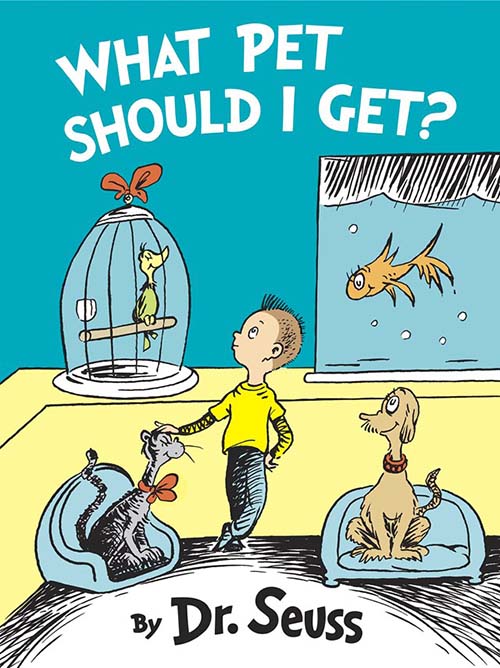
This never-before-seen picture book featuring original text and illustrations by Dr. Seuss uses the childhood experience of choosing a pet to illuminate a life lesson: it can be hard to make up your mind, but sometimes you just have to do it!
A good way to start our list of the top childhood story books : with something by the renowned Dr. Seuss.
Ages: C’mon, it’s Dr. Seuss: Children of all ages.
49. Where the Wild Things Are by Maurice Sendak

Where the Wild Things Are is 50 years old! Let the wild rumpus with Max and all the wild things continue as this classic comes to life as never before with new reproductions of Maurice Sendak’s artwork. Astonishing state-of-the-art technology faithfully captures the color and detail of the original illustrations. Sendak himself enthusiastically endorsed this impressive new interpretation of his art before his death in May 2012.
Winner of the 1964 Caldecott Medal for the Most Distinguished Picture Book of the Year, Where the Wild Things Are became an iconic book that has inspired a movie, an opera, and the imagination of generations. It continues to be one of the best loved childhood books of all time.
48. The True Story of the Three Little Pigs by A. Wolf, by Jon Scieszka
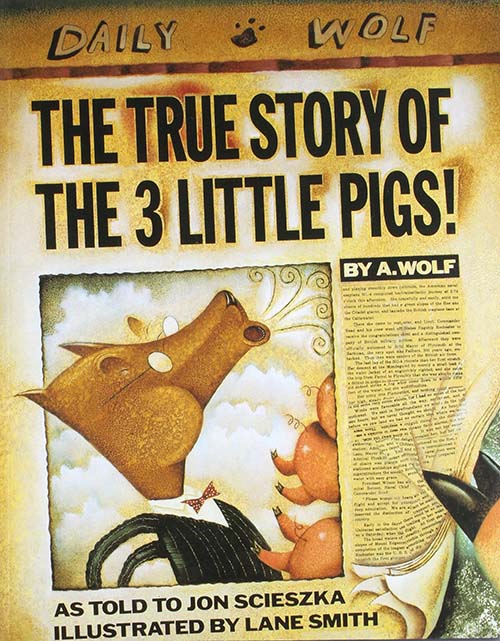
Alexander T. Wolf, now in jail for crimes against the three little pigs, insists he was framed. The truth, he explains, is that he visited the neighboring pigs’ homes asking for a cup of sugar to make a cake for his dear old granny. He notes he had a bad head cold that day. So, there was never any violent huffing and puffing, as the traditional story says. He just had a couple of bad sneezing fits.
When he found the first two lifeless pigs in their houses, which he’d accidentally blown down, he felt it would be wrong to leave food around to spoil. So, he ate ham . . . which, he says, would be just like his readers eating a big, juicy cheeseburger. He admits he was pounding violently at the third pig’s door when the cops arrived, but only because the pig had made derogatory remarks about granny. That’s when he was arrested, and the media spun the whole event to vilify him. This spin on fairy tales is a fun read for younger elementary school kids.
47. Corduroy by Don Freeman

A funny, timeless story of a slightly shabby teddy bear in need of a home (and a button for his overalls). He finds both, and a friend, when a little girl named Lisa uses her savings to buy him at the local department store.
Have you ever dreamed of being locked in a department store at night? The endearing story of Corduroy paints a picture of the adventures that might unfold (for a teddy bear at least) in such a situation. When all the shoppers have gone home for the night, Corduroy climbs down from the shelf to look for his missing button. It’s a brave new world! He accidentally gets on an elevator that he thinks must be a mountain and sees the furniture section that he thinks must be a palace. He tries to pull a button off the mattress, but he ends up falling off the bed and knocking over a lamp. The night watchman hears the crash, finds Corduroy, and puts him back on the shelf downstairs. The next morning, he finds that it’s his lucky day! A little girl buys him with money she saved in her piggy bank and takes him home to her room. Corduroy decides that this must be home and that Lisa must be his friend. This has been one of the favorite books of many since 1968.
46. Sylvester and the Magic Pebble by William Steig
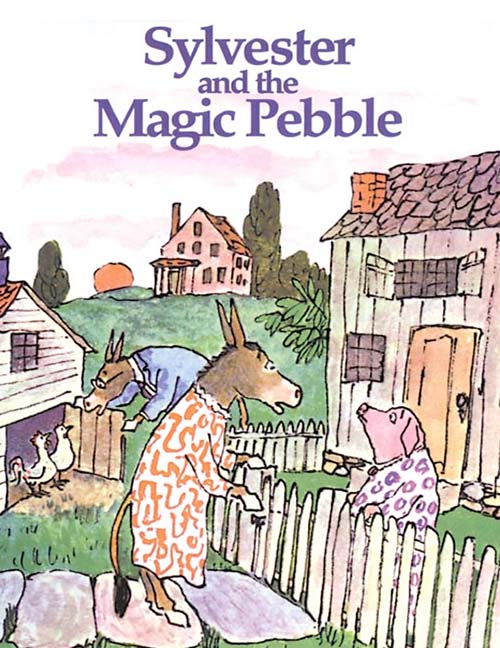
On a rainy day, Sylvester finds a magic pebble that can make wishes come true. But when a lion frightens him on his way home, Sylvester makes a wish that brings unexpected results.
How Sylvester is eventually reunited with his loving family and restored to his true self makes a story that is beautifully tender and filled with magic. Illustrated with William Steig’s glowing pictures, this is a modern classic beloved by children everywhere.
Selected as one of the 100 Best Books of the Century by the National Education Association, this is a top choice for younger readers.
45. Charlotte’s Web by E.B. White
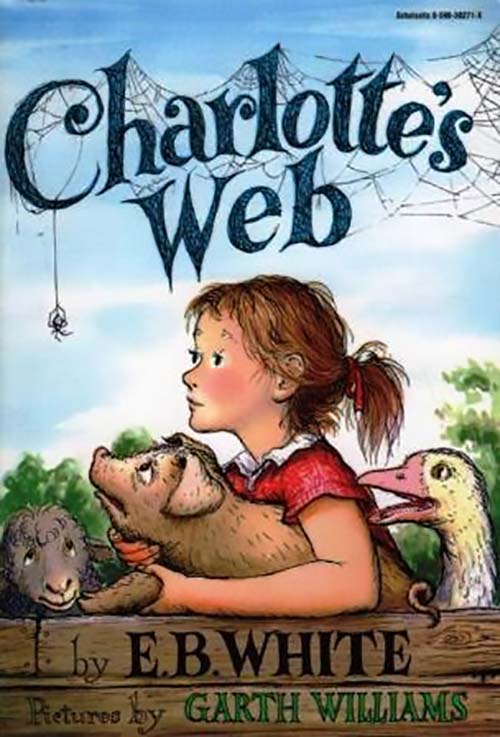
No early childhood classroom would be complete without a copy of Charlotte’s Web. American prose stylist E.B. White presents one of the best-loved stories of all time. And a heartwarming portrait of one of the best-loved pigs.
Wilbur is the runt of a litter born to a pig on the farm of Fern Arable’s father. When it is announced that her father is going to kill the pig, Fern rushes forth to save it, asking of her father: “If I had been very small at birth, would you have killed me?” Her father spares the pig, but only if Fern agrees to care for it. Falling in love immediately with the little pig, she feeds him regularly with a bottle, and names him Wilbur.
Wilbur is Fern’s constant companion until he grows big enough to be transferred to his new home in the barn of Fern’s neighboring uncle. Fern is able to visit Wilbur but is unable to see him as often. Out of boredom, Wilbur begins to befriend other animals in the barn, who often patronizingly instruct the still naïve little pig in the ways of life. His most important friend, however, turns out to be a spider named Charlotte, who occupies a web in the corner of a doorway above him. Her love for Wilbur, coupled with her ingenuity, will save Wilbur’s life.
A great choice for elementary school children, Charlotte’s Web has warmed the hearts of millions for nearly half a century.
44. Stuart Little by E.B. White

Another of the great E.B. White children’s books. Parents need to know that this book is an excellent bridge between chapter books and full-length novels. Stuart is both valiant and very polite. He finds himself on one of the biggest adventures of his life as he sets off to find a lost friend. He encounters several dangers in the process because of his size, but the mood stays light and imaginative.
Stuart proves to be a protagonist that many early childhood readers can admire and respect.
43. Rapunzel by Paul O. Zelinsky

One of the most popular fairy tales is the story of Rapunzel. Parents: remember your parents reading this to you as a kid? Well, the story still resonates with young readers. Trapped in a tower with no door, Rapunzel is allowed to see no one but the sorceress who has imprisoned her-until the day a young prince hears her singing to the forest birds. . . . The timeless tale of Rapunzel is vividly and magnificently brought to life through Paul O. Zelinsky’s powerful sense of narrative and his stunning oil paintings.
“Simply put, this is a gorgeous book; it demonstrates respect for the traditions of painting and the fairy tale while at the same time adhering to a singular, wholly original, artistic vision.”
A retelling of a folktale in which a beautiful girl with long golden hair is kept imprisoned in a lonely tower by a sorceress. Includes a note on the origins of the story. Perfect for those who love fairy tales.
Age range: 5-8
42. Puss in Boots by Charles Perrault
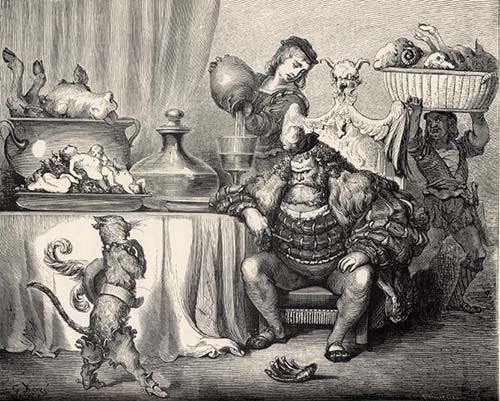
Charles Perrault’s “Puss in Boots” has been an irresistible magnet for countless illustrators ever since this classic French tale was originally published in 1697. So, the question arises: Do we really need another edition of “Puss”? Presented with Fred Marcellino’s magnificent interpretation of this nimble new translation of the authentic text, book lovers young and old are apt to decide that this “Puss in Boots” belongs on their shelf of special favorites and fairy tales.
Long regarded as the preeminent designer of book jackets in America, Fred Marcellino provides an unstinting visual feast in his first full-color picture book. The adventures of that rascal, Puss, and his master, the miller’s sonare portrayed in a lavish series of illustrations that range from sumptuous grandeur to comedy both boisterous and sly.
Age ranges: 3-5, 6-8
41. Is Your Mama a Llama? by Deborah Guarino
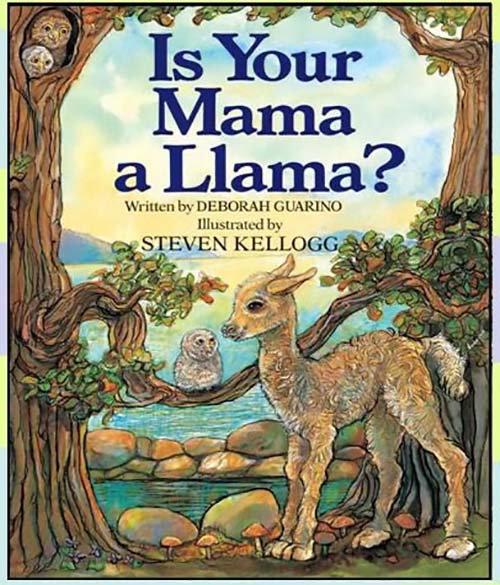
Simple, rhyming stanzas and bright, silly illustrations carry readers through Lloyd the Llama’s quizzing of his friends about their mamas. Lloyd the Llama discovers what kind of animal his mama really is in this delightful guessing game picture book, filled with whimsical riddles and endearing illustrations. Rhyming questions and answers will charm and amuse children. “An enchanting animal guessing game.”–School Library Journal. Full-color illustrations.
A young llama asks his friends if their mamas are llamas and finds out, in rhyme, that their mothers are other types of animals.
40. Pete’s a Pizza by William Steig
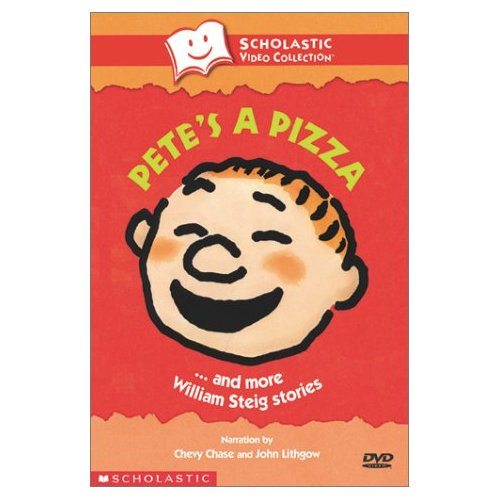
This is a wonderful book by an author who wrote it at age 83. You’d never know it.
Pete’s father starts kneading the dough. Next, some oil is generously applied. (It’s really water.) And then some tomatoes. (They’re really checkers.) When the dough gets tickled, it laughs like crazy. And your child will too (laugh).
39. The Paper Bag Princess by Robert Munsch

Before Pretty Princess Elizabeth can marry handsome Prince Ronald, a dragon burns down the castle and carries Ronald off. Dressed in a paper bag, the brave princess heroically finds the dragon’s cave, tricks the dragon into exhausting itself, saves Ronald while the dragon is sleeping.
Ronald then has only one thing to say to Elizabeth–that she is a mess! Elizabeth quickly realizes that she is better off without this ungrateful bum. Young feminists, here is a great book for you!
38. Owen by Kevin Henkes
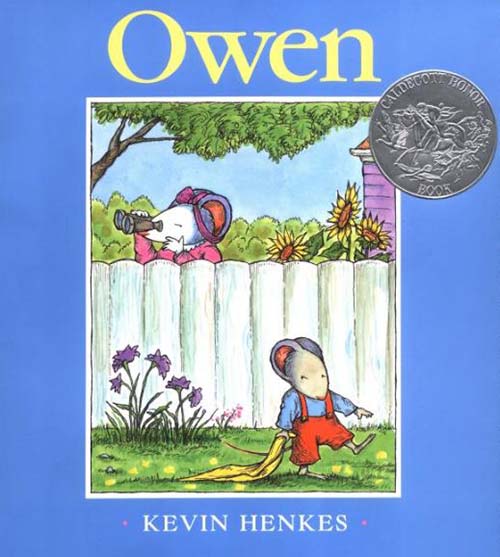
Owen had a fuzzy yellow blanket. “Fuzzy goes where I go,” said Owen. But Mrs. Tweezers disagreed. She thought Owen was too old for a blanket. Owen disagreed. No matter what Mrs. Tweezers came up with, Blanket Fairies or vinegar, Owen had the answer. But when school started, Owen’s mother knew just what to do, and everyone — Owen, Fuzzy, and even Mrs. Tweezers — was happy.
37. Nate the Great by Marjorie Weinman Sharmat
Beginning readers are introduced to the detective mystery genre in these chapter books. Perfect for the Common Core, kids can problem-solve with Nate, using logical thinking to solve mysteries! Nate the Great has a new case! His friend Annie has lost a picture. She wants Nate to help her find it. Nate the Great must get all the facts, ask the right questions, and narrow the list of suspects so he can solve the mystery. One of the top educational books for kids !
36. My Father’s Dragon by Ruth Stiles Gannett

The classic fantasy trilogy of Elmer Elevator and the flying baby dragon has delighted children and their parents for generations. A Newbery Honor Book and an ALA Notable Book, My Father’s Dragon is followed by Elmer and the Dragon (“rich, humorous, and thoroughly satisfying”*) and The Dragons of Blueland (“ingenious and plausible, the fantasy well-sustained”*).
Each story stands alone, but read in succession, they are an unforgettable experience.
35. Mr. Popper’s Penguins by Richard and Florence Atwater

The Poppers unexpectedly come into possession of a penguin, then get a penguin from the zoo who mates with the first penguin to have 10 baby penguins. Before long, something must be done before they eat the Poppers out of house and home! A classic of American humor, this story of a gentle housepainter and his high stepping penguins has delighted children for generations.
34. Miss Nelson is Missing! By Harry Allard and James Marshall
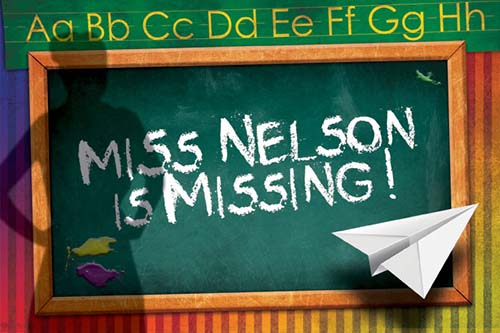
“The kids in Room 207 were misbehaving again. Spitballs stuck to the ceiling. Paper planes whizzing through the air. They were the worst-behaved class in the whole school.”
So begins this quirky classic, first published in 1977 and still relevant today as a lighthearted reminder to show our appreciation to those we value. The students don’t proffer a shred of respect for their good-natured teacher Miss Nelson, but when the witchy substitute Miss Viola Swamp appears on the scene, they start to regret their own wicked ways.
James Marshall’s scritchy, cartoonish full-color ink and wash illustrations are hilarious. A back-to-school perennial for the elementary school crew! It may take you down memory lane.
33. Miss Bindergarten Gets Ready for Kindergarten by Joseph Slate
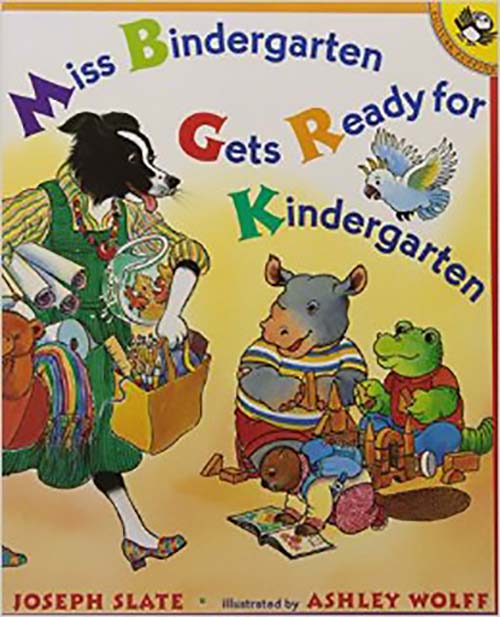
It’s the first day of kindergarten and Miss Bindergarten is hard at work getting the classroom ready for her twenty-six new students. Meanwhile, Adam Krupp wakes up, Brenda Heath brushes her teeth, and Christopher Beaker finds his sneaker. Miss Bindergarten puts the finishing touches on the room just in time, and the students arrive. Now the fun can begin!
This rhyming book is brightly illustrated. It is the perfect way to practice the alphabet and to introduce young children to kindergarten. One of the best educational books for kindergarteners !
32. Mike Mulligan and His Steam Shovel by Virginia Lee Burton
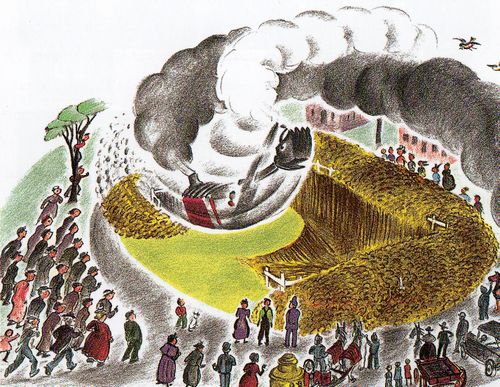
A modern classic that no child should miss.
Since it was first published in 1939, Mike Mulligan and His Steam Shovel has delighted generations of children. Mike and his trusty steam shovel, Mary Anne, dig deep canals for boats to travel through, cut mountain passes for trains, and hollow out cellars for city skyscrapers — the very symbol of industrial America. But with progress come new machines, and soon the inseparable duo are out of work. Mike believes that Mary Anne can dig as much in a day as one hundred men can dig in a week, and the two have one last chance to prove it and save Mary Anne from the scrap heap. What happens next in the small town of Popperville is a testament to their friendship, and to old-fashioned hard work and ingenuity.
31. Harold and the Purple Crayon by Crockett Johnson

One night, after thinking it over for some time, Harold decided to go for a walk in the moonlight.” So begins this gentle story that shows just how far your imagination can take you. Armed only with an oversized purple crayon, young Harold draws himself a landscape full of beauty and excitement. But this is no hare-brained, impulsive flight of fantasy.
Cherubic, round-headed Harold conducts his adventure with the utmost prudence, letting his imagination run free, but keeping his wits about him all the while. He takes the necessary purple-crayon precautions: drawing landmarks to ensure he won’t get lost; sketching a boat when he finds himself in deep water; and creating a purple pie picnic when he feels the first pangs of hunger.
30. Madeline by Ludwig Bemelmans
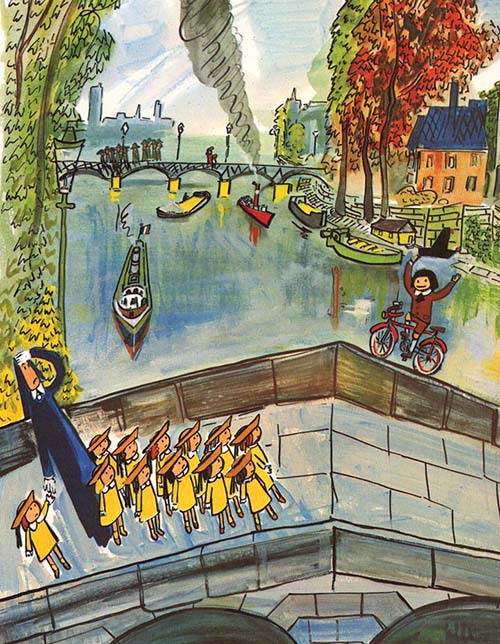
In an old, vine-covered house in Paris live 12 little girls. They wear wide-brimmed hats and matching yellow outfits, and walk in two perfect rows. Madeline is the smallest girl, and the most daring. She’s not afraid to touch a mouse or go near a tiger in the zoo.
But one night she wakes up in pain and Madame Clavel, the mistress of the house, can hear Madeline crying all the way from her own bedroom. Madame Clavel calls the doctor, and in no time, Madeline is rushed to the hospital to have her appendix removed. Everyone at the house misses Madeline, and Madame Clavel decides to take the 11 girls to visit their little friend in the hospital. They take her flowers and find Madeline in her hospital bed happily surrounded by the gifts of toys and candies she has received from well-wishers.
Ludwig Bemelmans was awarded the Caldecott Medal for his classic story, the first in his highly acclaimed and beloved Madeline book series. His verse is simple and fun and a pleasure to read. His illustrations, featuring famous Parisian landmarks like the Opera and the Place Vendome, are as charming and lively as the 12 little girls, including the precocious main character Madeline, at the heart of his story.
29. The Tale of Peter Rabbit by Beatrix Potter
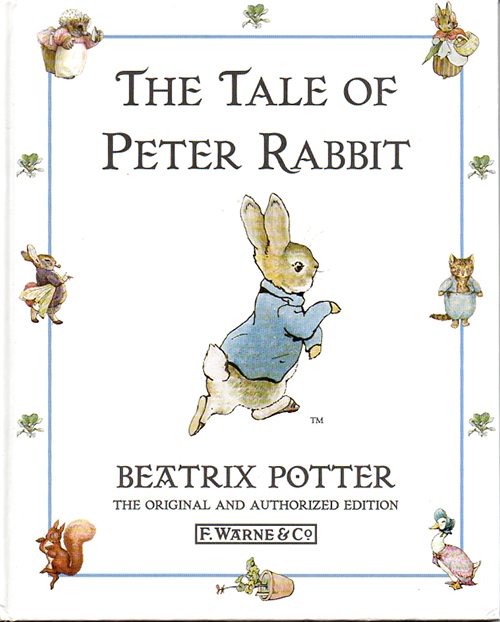
The quintessential cautionary tale, Peter Rabbit warns naughty children about the grave consequences of misbehaving. When Mrs. Rabbit beseeches her four furry children not to go into Mr. McGregor’s garden, the impish Peter naturally takes this as an open invitation to create mischief. He quickly gets in over his head, when he is spotted by farmer McGregor himself. Any child with a spark of sass will find Peter’s adventures remarkably familiar. And they’ll see in Flopsy, Mopsy, and Cotton-tail that bane of their existence: the “good” sibling who always does the right thing. One earns bread and milk and blackberries for supper, while the obstinate folly of the other warrants medicine and an early bedtime. This beloved children’s book has been a classic for years!
28. Don’t Let the Pigeon Drive the Bus by Mo Willems
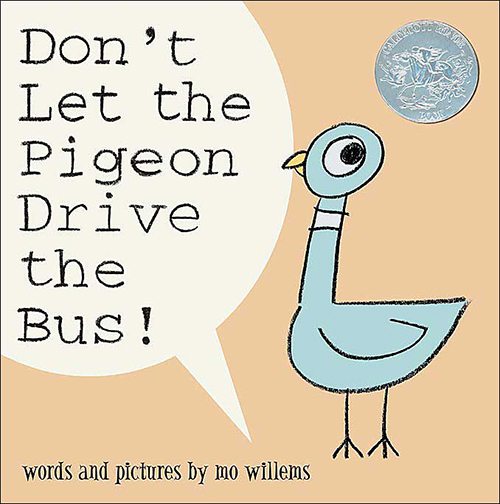
When a bus driver takes a break from his route, a very unlikely volunteer springs up to take his place-a pigeon! But you’ve never met one like this before. As he pleads, wheedles, and begs his way through the book, children will love being able to answer back and decide his fate.
In his hilarious picture book debut, popular cartoonist Mo Willems perfectly captures a preschooler’s temper tantrum.
27. Runaway Bunny by Margaret Wise Brown
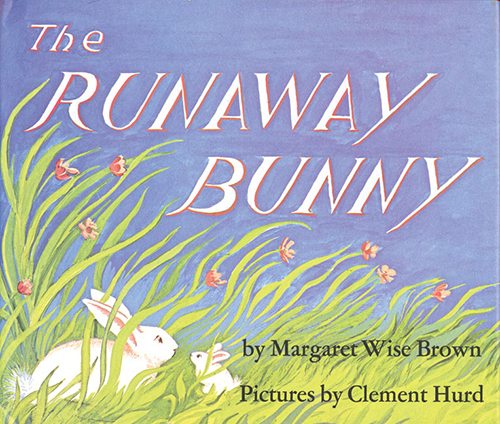
Illustrated by Clement Hurd (Goodnight Moon), and in continuous publication since 1942, the book tells the story of a mother’s unconditional love for her child.
As her baby bunny tells her of his plans to run away, the pair engage in a make-believe game of chase, where she morphs into a variety of forms and characters (a crocus and a mountain climber) to find him, no matter how far away he travels
Many children may wonder what it would be like to strike out on their own, but seldom imagine it as beautifully as the little bunny in this classic tale. The little bunny dreams of becoming a fish, a bird and even a “crocus in a hidden garden.” With each new incarnation the bunny imagines, his mother promises to become a fisherman, a tree and a gardener so that she may still watch over, guide and protect her little bunny. Realizing that his mother’s love is unwavering, the little bunny concedes defeat and decides he would be wise to stay home and just be himself. This picture book edition of the beautiful fable is perfect for even the smallest listener.
Ages: 6 mo.-5 years
26. Whistle for Willie by Ezra Jack Keats

If Peter could only learn to whistle, then his dog, Willie would hear him and come running. But nothing Peter does seems to help. He tries spinning around and around but it only makes him dizzy. He draws a long line with colored chalk; he walks along a crack in the sidewalk. He even wears his father’s hat and tries running away from his own shadow! It’s not until Peter least expects it that his wish comes true, and he blows a whistle that brings Willie running.
Caldecott award-winner Ezra Jack Keats tells his delightful tale in simple, easy-to-follow writing, and with his bold, colorful illustrations — of yellow-and-pink bricked buildings, barbershop poles, and girls skipping rope — he captures perfectly a summer’s day in the city as seen through the eyes of a child.
25. Brown Bear, Brown Bear, What Do You See? by Bill Martin, Jr.

Beautifully and boldly illustrated by Eric Carle (The Very Hungry Caterpillar), this classic picture book is easy on the ears, with its rhymes and repetition. The question-and-answer format invites young listeners to participate in “reading” the book.
Four decades and 7 million copies ago, Brown Bear, Brown Bear, What Do You See? first appeared in bookstores. The first collaboration of Bill Martin Jr. and Eric Carle earned laudable advance notices, but no one anticipated that it would take off like wildfire.
Now the publisher honors this picture book classic with an anniversary edition that includes an audio CD containing the full text, plus commentary by Martin and Carle.
24. Wheels on the Bus by Raffi
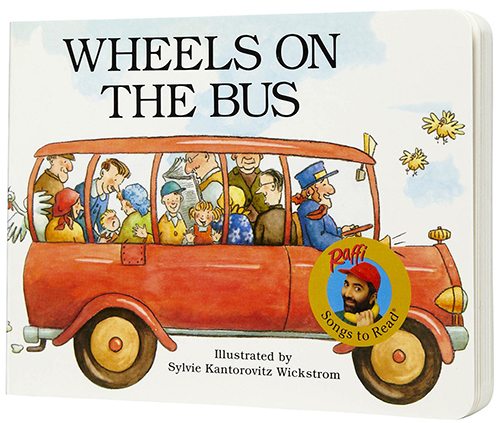
Parents and children alike can participate in the repetitive lyrics and motions (the swishing of the windshield wipers and the beeping of the horn) of this classic children’s song in picture book form, from Raffi’s “Songs to Read” collection. The illustrations show a rickety, old bus moving an assortment of quirky passengers through a village. Traditional musical notation and lyrics are included. It is a perfect first book for early childhood.
Singing and reading to your child are considered two of the most vital ways parents can stimulate the development of a child’s brain during the earliest years. Raffi’s Songs to Read unites the rhythm, rhyme, and repetition that helps to lay the foundation for later speech, listening, and reading skills. Here with fresh new cover designs are some of Raffi’s best-known songs. With enchanting illustrations, they create educational children’s books that are natural bridges between music and reading.
23. Pat the Bunny by Dorothy Kunhardt
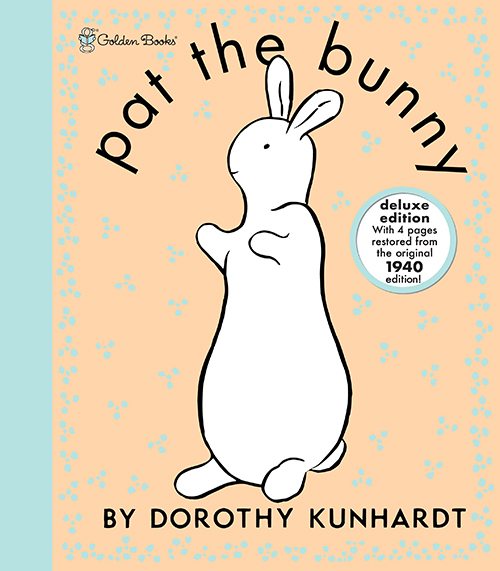
For more than seventy years, Pat the Bunny’s Paul and Judy have been entertaining children, playing peekaboo and sniffing flowers with generations of appreciative readers and readers-to-be. Now this classic touch-and-feel invites you to pet the bunny.
A sweet, interactive book that encourages children to smell (the flowers), touch (the soft bunny), feel (Daddy’s scratchy face) and play (peek-a-boo with Paul). First published in 1940, the book remains a must-read favorite. This is a great book for little ones.
Ages: newborn to 3
22. Time to Get Dressed! by Elivia Savadier
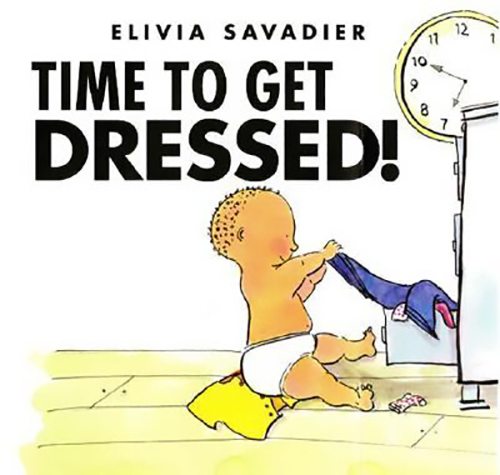
Little Solomon insists on dressing himself but gets everything wrong (shirt on his legs and pants on his head) until Daddy looks at the clock and steps in to help. Parents and little ones will relate to the fierce independence of this toddler, who shouts ‘ME!’ with every article of clothing.
Savadier’s pictures and dialogue once again showcase a gift for economy and humor, while key words (e.g., socks, shoes) appear in bold, crisp type. Her two-man cast is inspired: Daddy, a well-upholstered man with thinning hair and patience, is every bit as funny in his contortions and expressions as his stubborn offspring (with a similarly underdeveloped pate). Savadier’s watercolor-and-ink drawings exude the same elegant fluidity as in her previous book, but the work feels tighter here, her observations more firmly tethered to domestic reality. Readers’ laughs will be just as abundant as the glee of Solomon’s final, cereal-soaked triumph.
21. The Snowy Day by Ezra Jack Keats
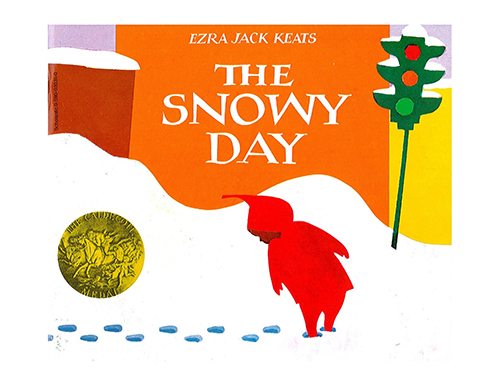
This Caldecott Medal-winning classic picture book depicts the wonder and delight a child can find when snow blankets his world, making snowballs (one of which he brings home in his pocket!), snow angels, a snowman and loads of fun.
No book has captured the magic and sense of possibility of the first snowfall better than The Snowy Day. Universal in its appeal, the story has become a favorite of millions, as it reveals a child’s wonder at a new world, and the hope of capturing and keeping that wonder forever.
These are the adventures of a little boy in the city on a very snowy day.
Ages: Newborn to 3
20. Peek-a-boo! by Roberta Grobel Intrater
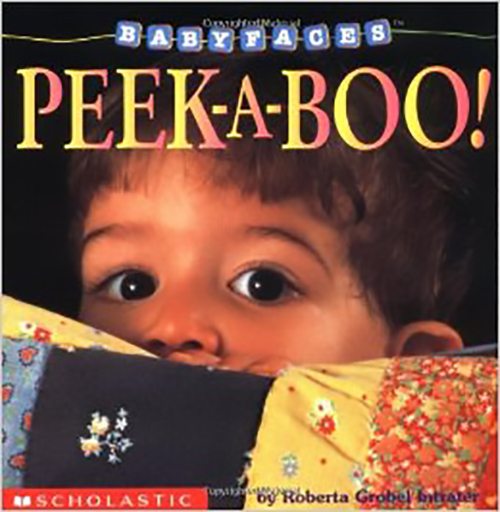
Close-up photographs of babies’ faces capture their many moods, from laughing to yawning to pouting to crying, in this board book from the “Baby Faces” series. The captivating photos will enchant babies, and parents will be charmed by the cute expressions the book elicits from their own babe. It’s a must have resource for any early learning teacher.
Babies are fascinated by other babies and will love to hold these small sturdy books in their hands and gaze at the candid and appealing photographs of all kinds of baby faces. Each book in the series focuses on a different activity and explores concepts babies and toddlers can grasp. They contain 10 pages of large, vibrant color portraits with distinctive black backgrounds, and a simple rhyming text appropriate for the youngest children. Their durable glossy finish and rounded corners make them safe for handling by infants and toddlers. These are ideal first read-aloud books, and their small convenient size is just right for taking along.
19. Love You Forever by Robert Munsch

A sweet, tear-provoking story of the evolving relationship between a boy and his mother. It follows the pair from his infancy into his adulthood, as their roles shift and responsibility for the other shifts from mother to son, who has become a father to a little girl of his own by the book’s end. Do not attempt to read without tissues close at hand.
A young mother holds her newborn son and looks at him lovingly. Softly she sings to him “I’ll love you forever, I’ll love you always.” This is a gentle affirmation of the love a parent feels for their child — forever.
An extraordinarily different story by Robert Munsch is a gentle affirmation of the love a parent feels for their child — forever. Sheila McGraw’s soft and colorful pastels perfectly complement the sentiment of the book — one that will be read repeatedly for years
18. Kitten’s First Full Moon by Kevin Henkes

In this Caldecott Medal-winning children’s book, black-and-white illustrations capture the struggle of Kitten who, upon viewing her first full moon, mistakes it for a bowl of milk and embarks on a quest to reach it. Although the milk in the sky eludes her, the story ends happily when Kitten returns home from her adventures to find an actual bowl of milk waiting for her. The nationally bestselling early education picture book about a kitten, the moon, and a bowl of milk, is written by the celebrated author and illustrator Kevin Henkes, was awarded a Caldecott Medal.
17. Are You My Mother? By P.D. Eastman

This classic tale follows a baby bird as the main character on a quest to find his mother after falling from his nest. He asks a kitten, a hen, a dog, a cow, an airplane and a snort (actually a steam shovel) if they are his mother, before eventually being reunited with her, back in the nest.
This wonderful book tells a very simple story for children who have just started to read. their younger brothers or sisters will also want to follow the baby bird’s quest as he asks everyone and everything he meets, “Are You My Mother?”. Back in 1957, Theodor Geisel responded to an article in Life magazine that lamented the use of boring reading primers in schools. Using the pseudonym of “Dr. Seuss” (Seuss was Geisel’s middle name) and only two hundred twenty-three words, Geisel created a replacement for those dull primers: “The Cat in the Hat.” The instant success of the book prompted Geisel and his wife to found Beginner Books, and Geisel wrote many popular books in this series, including “Hop on Pop,” “Fox in Socks,” and “Green Eggs and Ham.”
16. Good Night, Gorilla by Peggy Rathmann

This clever bedtime tale follows a mischievous gorilla who snatches a zookeeper’s keys and releases all of his animal friends to secretly spend the night at the zookeeper’s house. With minimal text, the narrative is told mostly through pictures, inviting parents and children to describe what’s happening and invent the details of the story.
As she did in her Caldecott Medal-winning Officer Buckle and Gloria, Peggy Rathmann uses her expressive, richly colored pictures to give young readers a joyful look at what animals might do when people’s backs are turned. Observant children will find extra fun in poring over the illustrations to follow the progress of a released balloon into the sky, laugh at Mouse’s valiant efforts to carry one of Gorilla’s bananas from cage to cage to house, find the animals in the zookeeper’s family photos, and note the appropriate toys each animal has to play with (is that a Babar doll in the elephant cage?). Irrepressible fun for any time of day, Good Night, Gorilla is a gem of a picture book from an award-winning author and illustrator.
15. In the Tall, Tall Grass by Denise Fleming

Bright, colorful illustrations show animals and insects found in a child’s backyard, as seen through a caterpillar’s point-of-view, as they crunch, munch, zip and sip their way through the day.
Little ones (and their preschool teachers) will enjoy looking for the yellow and orange caterpillar on each page and counting the insects as they listen to the simple, rhyming text.
14. Dear Zoo by Rod Campbell

A classic lift-the-flap book, the story begins with a child’s letter to the zoo, requesting a pet. A series of animals arrive—under flaps to be uncovered by the reader—and are discovered to be not quite right (too heavy, too scary, too naughty), until at long last, the perfect pet appears.
Celebrate the 25th anniversary of Rod Campbell’s delightful lift-the-flap classic with this sturdy board book version for toddlers. The artwork has been updated for a spiffy new look, but the charming story line remains unchanged: A child writes a letter to the zoo, requesting a pet. The zoo sends back a parade of animals, all of them unsuitable for one reason or another. Each colorful spread depicts a container (a basket, a crate, a cage, etc.), revealing just enough of the mysterious contents to encourage fun-filled guessing. But the real enjoyment is watching the delight on children’s faces as the last shipment arrives with (ta-da!) the perfect pet. A perennial family favorite.
Ages: Baby to 4
13. Gossie by Olivier Dunrea
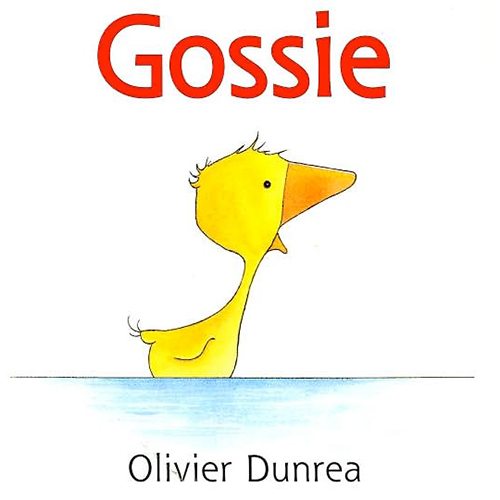
Meet Gossie, a small yellow gosling who loves to wear bright red boots—every day. One morning Gossie can’t find her beloved boots. She looks everywhere for them: under the bed, over the wall, even in the barn. Preschoolers will enjoy helping Gossie find her red boots and delight in where Gossie finally finds them.
Gossie is a gosling who likes to wear bright red boots every day, no matter what she is doing, and so she is heartbroken the day the boots are missing and she can’t find them anywhere.
12. “More More More,” Said the Baby: 3 Love Stories by Vera B. Williams
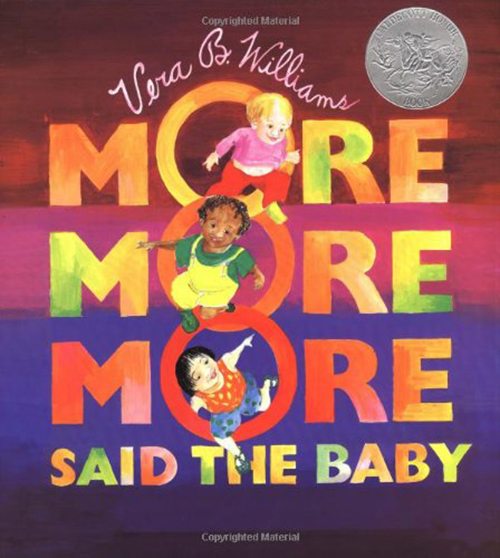
Told in an engaging musical rhythm, the book introduces readers to multiracial and multi-generational stories about three toddlers (Little Bird is Asian-American, Little Pumpkin is African-American and Little Guy is white) and their caregivers. The lilting text and joyous, vibrant illustrations successfully impart the message that love is universal. This Caldecott Honor Book is a good book for toddlers.
From beneath the tickles, kisses, and unfettered affection showered on them by grownups, the children in the book cry out for more more more! The stars of three little love stories – toddlers with nicknames like “Little Pumpkin” – run giggling until they are scooped up by adoring adults to be swung around, kissed, and finally tucked into bed.
Quirky watercolor drawings and colorful text feature multi-ethnic families, and young readers will rejoice in seeing the center of all the attention: the wiggly, chubby, irresistible toddlers. A must read for any early education classroom.
11. Busy Penguins by John Schindel
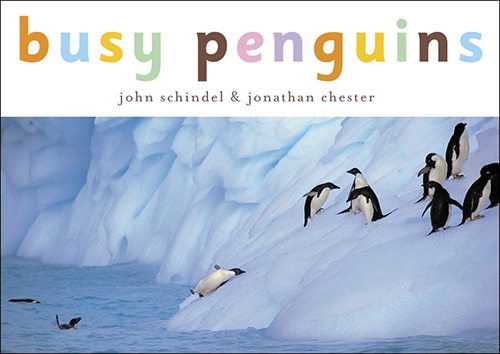
In this photographic board book, simple rhyming word pairs (penguins splashing/penguins dashing and penguins drooping/penguins pooping) introduce the daily life of penguins. Author John Schindel partnered with a variety of photographers for more than a dozen other books in the “Busy Book” series, including Busy Doggies, Busy Monkeys, Busy Pandas and Busy Horsies.
There’s so much to do when you’re a penguin, isn’t there? Join in the fun! The rhyming text and adorable photographs in this colorful board book offer a close-up view of penguins dashing, splashing, jumping, bumping, and going about their busy penguin lives.
Ages: Newborn-3
10. Guess How Much I Love You by Sam McBratney
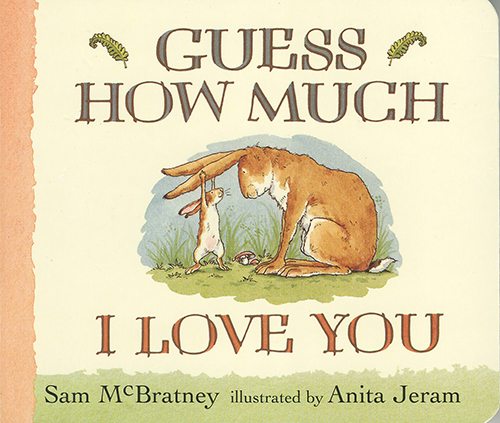
A young bunny and his dad sweetly try to one-up each other with how big their love for the other is in this sweet tale, illustrated with gorgeous watercolors. It’s a lovely tale of unconditional love, perfect for the babe you love “all the way to the moon—and back.”
9. Five Little Monkeys Jumping on the Bed by Eileen Christelow
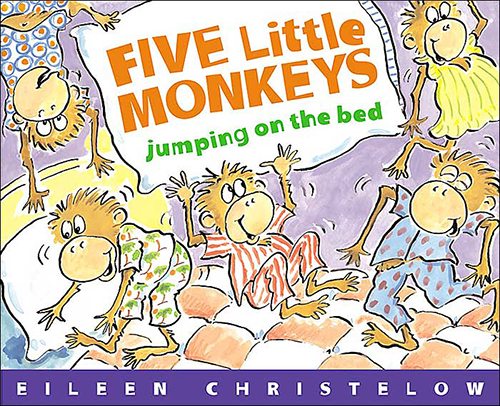
Extending the well-known song, this picture book features five little monkeys preparing for bed, as they bathe, put on their pajamas, brush their teeth and then jump on the bed, falling off one-by-one. Kids will enjoy the repetition and rhyming, and parents will totally relate to the exhausted mama monkey.
“NO MORE MONKEYS JUMPING ON THE BED!” The nursery rhyme “Five Little Monkeys” has long been a favorite song and finger play with the preschool set, but Eileen Christelow gives it new life as a hilarious picture book. Her expressive pencil and watercolor illustrations capture both the glee and the pratfalls of those misbehaving monkeys. A sure-fire hit at story hour, this rhythmic romp is a counting lesson, too, as the five bouncy bed-jumpers bump their heads and get hauled off to the doctor one by one. (IRA/CBC Children’s Choice Award, 1990)
8. Charlie and the Chocolate Factory by Roald Dahl
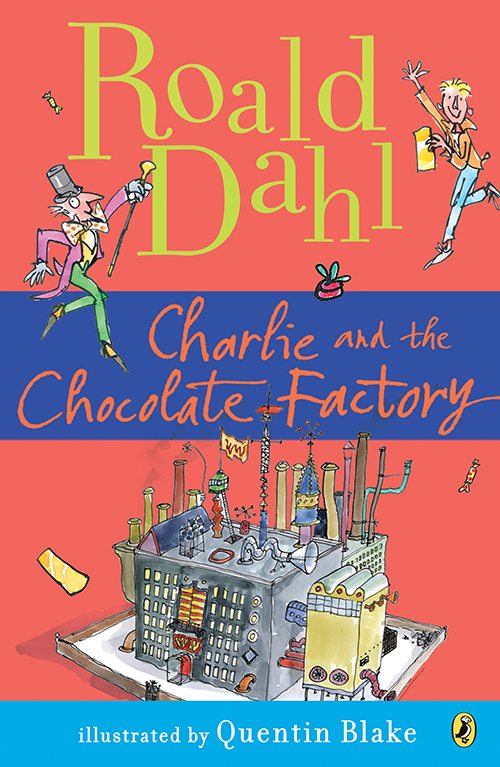
In this timeless classic, Willy Wonka, a crazy chocolatier, opens his chocolate factory doors for the first time to five lucky children who have randomly purchased the coveted chocolate bars containing the golden ticket. Besides a lifetime supply of chocolate, the children get a chance to tour the mysterious factory with their guide, Willy Wonka. Throughout their journey in Wonka’s factory the children encounter all sorts of silliness, as well as ethical dilemmas.
Roald Dahl presents readers with four devious, self-serving children, Augustus Gloop, Veruca Salt, Violet Beauregarde, and Mike Teavee, while Charlie Bucket represents the contrast in character. The four other children’s selfish ways get them into hilariously odd situations, which have the result of determining their own doom, while Charlie’s characteristic integrity, honesty, and general sweetness afford him an opportunity to fulfill his dreams. This fantasy allows readers to explore how character and certainly behavior may affect the course of one’s life in a way that is fun and imaginative. This is a perennial classic that continues to be enjoyed by readers, young and old.
7. Close Your Eyes by Kate Banks

A mother tiger encourages her restless cub to settle down to sleep by describing the dreams he may have, reassuring him that she’ll be there when he wakes, and that “Dark is just the other side of light. It’s what comes before dreams.” Aw.
Lush paintings by Georg Hallensleben (And If the Moon Could Talk) capture the off-kilter world of dreams and the beauty of the natural world, as the scenes shift back and forth between reality and fantasy.
6. My Very First Mother Goose, edited by Iona Opie
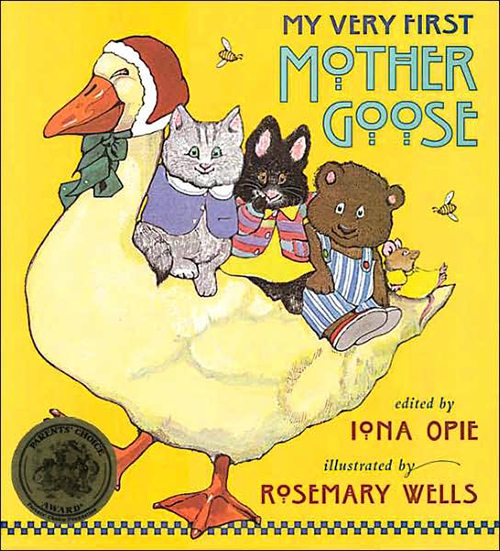
Cheerful illustrations featuring Rosemary Wells’ (of “Max and Ruby” fame) stylized animal characters accompany more than 60 nursery rhymes both familiar and lesser-known, and help to introduce young listeners to the pleasures of sing-song language.
To a small child, words are magical. And the most magical of all are the beloved, venerable words of Mother Goose. Now folklorist Iona Opie has gathered more than sixty treasured rhymes in their most perfect, honest form. From “Hey Diddle, Diddle” and “Pat-a-Cake” to “Little Jack Horner” and “Pussycat, Pussycat,” these are familiar verses that have been passed from parent to child for generations; these are the rhymes that are every child’s birthright. With watercolors by Rosemary Wells that may prove equally enduring,
MY VERY FIRST MOTHER GOOSE captures the simple joy and the sly humor that are the essence of Mother Goose. Parents and children will find themselves exploring this volume together, savoring delightful details and funny surprises on every page.
Age Range: 2-8
5. The Very Hungry Caterpillar by Eric Carle

A hungry caterpillar eats his way through a varied and very large quantity of food until, full at last, he forms a cocoon around himself and goes to sleep.
One of the best-selling children’s books of all time, The Very Hungry Caterpillar has been delighting young readers for over thirty years. This classic book will continue to introduce new generations of children to the magical world of Eric Carle.
4. The Complete Tales and Poems of Winnie the Pooh by A.A. Milne
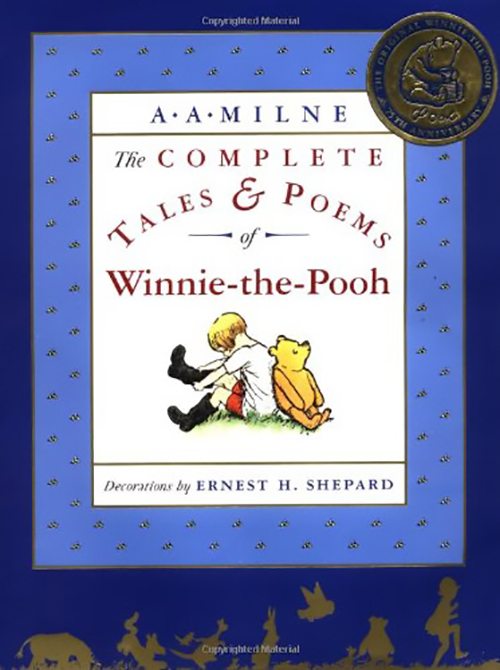
In 1926, Winnie-the-Pooh, a collection of stories about a rather stout, somewhat confused bear, was published in England and America. The enchanting tales of Pooh, Piglet, Eeyore, Christopher Robin, and the others were an immediate success, and firmly established A.A. Milne, already an acclaimed dramatist, as a major author of children’s books. Winnie-the-Pooh was followed in 1928 by a second collection, The House At Pooh Corner, which continued the adventures from the Hundred Acre Wood and introduced bouncy, lovable Tigger.
Age: Readers of ALL ages
3. The Cat in the Hat by Dr. Seuss
Join the Cat in the Hat as he makes learning to read a joy! It’s a rainy day and Dick and Sally can’t find anything to do . . . until the Cat in the Hat unexpectedly appears and turns their dreary afternoon into a fun-filled extravaganza! This beloved Beginner Book by Dr. Seuss, which also features timeless Dr. Seuss characters such as Fish and Thing 1 and Thing 2, is fun to read aloud and easy to read alone. Written using 236 different words that any first or second grader can read, it’s a fixture in home and school libraries and a favorite among parents, beginning readers, preschool teachers, and librarians.
2. The Ugly Duckling by Hans Christian Andersen
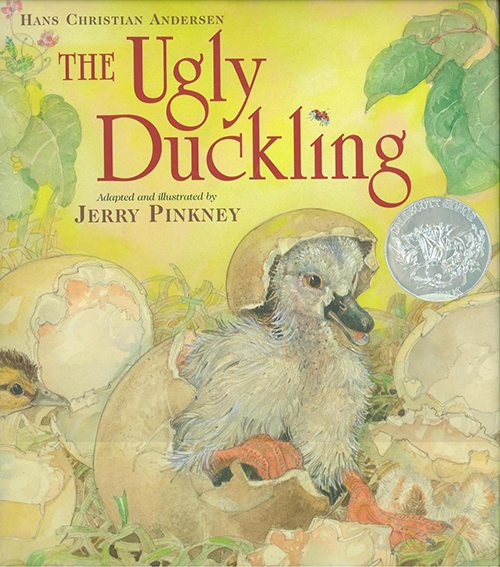
An ugly duckling spends an unhappy year ostracized by the other animals before he grows into a beautiful swan.
Parents need to know that kids will be drawn into the detailed illustrations, and empathize with the forlorn fowl. Positive messages about acceptance abound, and there’s nothing here that kids can’t handle.
1. Goodnight Moon, By Margaret Wise Brown
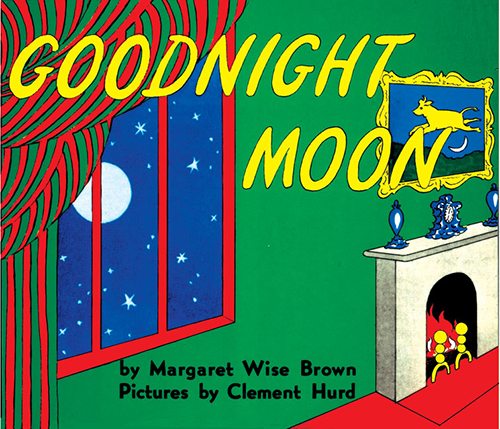
Perhaps a strange choice for number 1 on our list. But…think about it. This is an acknowledged classic first starter for tots. A masterpiece that will endear children to reading forever.
This is the classic board book story of a little rabbit at bedtime, with illustrations by Clement Hurd. Such beautiful language too: In the great green room There was a telephone And a red balloon And a picture of— The cow jumping over the moon. Many books have been written since Goodnight Moon, but it has stood the test of time.
Best for kids up to age 2.

Introduction to Curriculum for Early Childhood Education
(16 reviews)
Jennifer Paris, College of the Canyons
Kristin Beeve, College of the Canyons
Clint Springer, College of the Canyons
Copyright Year: 2018
Last Update: 2019
Publisher: College of the Canyons
Language: English
Formats Available
Conditions of use.
Learn more about reviews.
Reviewed by Felix Rodriguez Suero, Lecturer I, University of Texas Rio Grande Valley on 11/9/22
This book addresses a wide range of topics pertaining to curriculum design and inquiry with young children. Learning through Play is a central focus of the book. However, the authors introduce the reader to the most common approaches to early... read more
Comprehensiveness rating: 5 see less
This book addresses a wide range of topics pertaining to curriculum design and inquiry with young children. Learning through Play is a central focus of the book. However, the authors introduce the reader to the most common approaches to early childhood education.
Content Accuracy rating: 5
I think that at times the authors rely too much on secondary documents instead of citing scientific research findings directly. However, the authors draw from relevant theories and anecdotes to illustrate what the application of specific pedagogical principles may look like in practice, which I found particularly valuable for education students at the undergraduate level in general.
Relevance/Longevity rating: 5
One of the important contributions of this book is summarizing in one place, theories, principles, and concepts that often demand the use multiple books and articles. This book gives future teachers a good grasp of essential concepts such as transitions, routines, student readiness, assessment, and documentation. In addition to the solid discussion of the traditional literature, future editions could benefit from discussions on the contributions of neuroscience to how we understand young children's learning.
Clarity rating: 5
The authors use a language that is clear and accessible. Some of the articles I assign in my Art Education method courses can be hard to read for some of my undergraduate students. I am considering substituting some of those articles with chapters and sections from this book.
Consistency rating: 4
The organization of the book is consistent throughout the different chapters. The pop-up windows "Vignette" and "Pause and Reflect" add content and experiences that facilitate the connection between theory and practice.
Modularity rating: 5
In my case, not all chapters are useful for the courses I currently teach, but the book structure makes it conducive to assign specific chapters that align with some of my weekly topics.
Organization/Structure/Flow rating: 5
The book is organized into five large thematic sections. Each section is divided into uneven number of chapters. However, the organization of the text is consistent throughout the different chapters. The book starts with more general theoretical and practical considerations that could be useful to students from different disciplines. Section IV, covering Chapters 7-16 provides insights into specific subject areas.
Interface rating: 2
While the book is comprehensive and useful for introduction to curriculum design and education method courses, the interface of the book could benefit from more elaborate formatting and design. Several images are low resolution, and the format and quality are not consistent. In general, a more professional design could make the book more visually appealing.
Grammatical Errors rating: 5
I did not notice significant grammatical errors.
Cultural Relevance rating: 5
The authors are attentive to how cultural and social factors affect students’ engagement. They intentionally examine learning experiences from diverse cultural settings and discuss how disadvantage students may lack access to technology.
I was expecting more specialized and in-depth discussions on the Creative Arts in Chapter 11. Nonetheless, this book is a great resource to address general curriculum design considerations with young children. I plan to use this book in the future.
Reviewed by Ilfa Zhulamanova, Associate Professor, University of Southern Indiana on 5/19/22
This text brings a comprehensive approach to curriculum making in early childhood education. I really liked the emphasis on play-centered approach to education of young children. read more
This text brings a comprehensive approach to curriculum making in early childhood education. I really liked the emphasis on play-centered approach to education of young children.
The content information is researched-based, unbiased and accurate.
The text consists of best practices experienced and grounded in research for the education of young children. The text is written and/or arranged in such a way that necessary updates will be relatively easy and straightforward to implement.
The text is clearly written, full of examples and visual graphs, charts, tables, and photos. The language is appropriate for the context.
Consistency rating: 5
There is a consistency in organization, terminology and framework of the book which makes it easy to follow. Each chapter begins with objectives and brief introductions. I really like the Pause to Reflect sections included throughout the text.
The text content is divided into sixteen chapters which can be easily and readily divisible into smaller reading sections that can be assigned at different points within the course. Instructors will find this format easy to follow to organize their course.
The content topics are presented in a logical, clear fashion.
Interface rating: 5
The text is free of significant interface issues, including navigation problems, distortion of images/charts.
The book is readable with no grammatical errors.
Cultural Relevance rating: 4
The text book content and images represent diverse population of children and families schools serve today. More information on teaching children with special needs and ESL/ELL students would make this book more appealing to instructors.
Reviewed by Robert Bryant, Adjunct Professor, Dominican University on 4/25/22
The text is readable and complete in scope and Early Childhood responsibilities. read more
The text is readable and complete in scope and Early Childhood responsibilities.
The text shares accurate information that is correct and timely based on current research.
The text is relevant in today's education environment.
The book is readable and compete.
The book focuses on nurturing care and attachment as paths for early learning.
The book has a preface and a table of contents.
The book is organized as a readable book, but also by chapter subject for easy reference on many topics.
The PDF download makes it convenient to use as a reference anywhere.
The book is relevant when compared to current early learning research.
Reviewed by Kimberly McFall, Associate Professor, Marshall University on 1/3/22
The book is arranged in a logical order and includes relevant up-to-date topics. read more
The book is arranged in a logical order and includes relevant up-to-date topics.
The book reflects accurate information
This book includes relevant topics that are arranged in a logical way. One thing that might be helpful is to make sure that terms/topics that are intertwined (technology and culture for example) are also noted in a chapter summary or hyperlinked from the Chapter Objectives sections for easy access/talking points for users.
The book is well written, grounded in research, and easy to read.
The book is consistent with current research, accuracy in data/tables and laid out in a way that the friendly to the user.
Modularity rating: 4
The text features a clearly laid out chapter objective section and chapter headers. I think that it would be made even stronger if the objectives were aligned to the headers or hyperlinked to the sections they support.
This book is well laid out and is scaffolded nicely throughout.
Interface rating: 4
An opportunity for strengthening this book, even more, is to provide hyperlinks from the chapter objects to the sections of the book where each objective is addressed. Also, since the author does such a nice job of supporting the content with cultural and technology references, keywords that are hyperlinked from the table of contents to these topics that are not stand-alone chapters might help users if they want to use this book in part/section.
Professional and accurate without grammatical error
As noted above, easier access to clickable links or noted where to find culturally relevant content would strengthen this area.
This is well thought out book that gives an in-depth look at early childhood education in a practical approach. More information about culturally responsive teaching would make this book a home run. The authors have done an outstanding job providing useful, researched-based information. One glaring issue is the lack of glossary or index and clickable links from Table of Contents and Chapter Objects would be helpful.
Reviewed by Robin Folkerts, Assistant Teacher Educator, Wichita State University on 10/30/21
There is a table of contents which is very helpful and transparent about the contents. I found the information in this text to be very comprehensive and thorough in regards to an introduction to Early Childhood Education. There is no index or... read more
Comprehensiveness rating: 4 see less
There is a table of contents which is very helpful and transparent about the contents. I found the information in this text to be very comprehensive and thorough in regards to an introduction to Early Childhood Education. There is no index or glossary to accompany this text.
I have taught this course with another book, and I find that the information in this resource is accurate and up to date. I did not find errors in my review, and I did not find anything that was biased in my opinion.
The topics are relevant, and the vignettes that are added in each chapter are valuable for deeper understanding of real life experiences. It is helpful for Early Childhood Education teacher candidates to have practical and specific examples of how theories are applied. I found the topics covered in this book to be important and well-represented.
The flow of the text is easy to follow. It is helpful to have tables and charts to help clarify information in the text. The objectives at the beginning are also helpful to clarify what is contained in each chapter. I appreciated the multiple lists that were included in the tables. The readability was easy and engaging. I found the tables and charts in the fourth section to be helpful in understanding developmentally what skills students have at certain ages and stages. I particularly enjoyed the chapter on teaching science where it was divided into sub-categories of earth science, life science, and physical science.
I see consistency throughout the resource in regard to text structure and text features. Each chapter begins with the objectives, and is laid out in an easy to read format with headings, tables, and vignettes (in green boxes) and research highlights (in purple boxes). The consistency made it easier to read and follow.
I found this text to be well-organized with text features used to keep information in manageable chunks. Illustrations and tables are used to help clarify information and it flows well for the reader. I especially like the vignettes that were consistently in green boxes. They are well-written and relevant.
I found this resource to be well-organized and easy to follow. It is divided into sections and chapters where the first three sections are more of an introduction, and the fourth section is the real meat and potatoes of curriculum and lesson planning. The final section gives an extension for other age groups.
The interface was exceptional. I downloaded it as a PDF and it was easy to navigate. I had no issues at all with any of the displays or features, and it would not be confusing or distracting to readers. This resource is easy to navigate and consistent in its format.
I did not identify any grammatical errors in my review of this resource. A link was included at the beginning to report any such findings.
While I did not see anything blatant, in comparison to the book that I currently use, there is not an entire chapter dedicated to cultural sensitivity. Rather, it is intertwined within the chapters. There was a piece in an early chapter that talked about including books and materials that are culturally diverse, There was a reference in the Infants and Toddlers chapter about cultural sensitivity as well as working together with families. English Language Learners is also not included as a chapter on its own, but is interwoven into the contents of this resource.
I enjoyed this resource very much, and I will plan to use it with my ECU: Foundations course that I teach. Well Done!
Reviewed by Jennifer Forker, Professor, Hutchinson Community College on 10/18/21
This textbook covers all of the major topics for developing a curriculum in a preschool setting. read more
This textbook covers all of the major topics for developing a curriculum in a preschool setting.
The book breaks down each developmental level expectations in a way that is easy to read and understand.
Relevance/Longevity rating: 4
The textbook focuses on the California Early Learning Standards, but can easily be adapted to your state framework.
The textbook uses phrases that should be common knowledge to all early childhood education professionals.
The chapters are laid out similarly so the student always knows what to expect.
Each subtopic is in its own chapter and can be easily skipped (or added to) if needed.
The book flowed easily from basic theorist knowledge to more in depth procedures on how to incorporate curriculum into your classroom.
The links provided in the footnotes are live and easy to access.
I did not see any grammatical errors.
The photos used were inclusive and representative.
The vignettes provided real life examples of best practices in early childhood education.
Reviewed by Diane Lewis, Adjunct Professor, Northern Essex Community College on 4/6/21
I really like how the book is broken down into sections and works from the understanding how children learn to developing curriculum. I like seeing how to set stage for learning and guiding behavior in classroom. I like how the book wraps up the... read more
I really like how the book is broken down into sections and works from the understanding how children learn to developing curriculum. I like seeing how to set stage for learning and guiding behavior in classroom. I like how the book wraps up the last 9 chapters with what the curriculum looks like. Concluding with documentation and assessment is a great way to end the students learning. This book will be very helpful in many classes in ECE.
As I was reading I found the information to be accurate and error-free. The author is unbiased.
It will be pretty easy to update what would need to be updated as years go by.
I really liked the clarity and the examples in the chapters. Not much jargon/technical terminology to confuse the reader. Easy to read.
I liked how the book started in the understanding and ended with examples. The text was consistent in how it was written.
Different chapters can be spaced out over the course and also through other courses as well. It can easily be broken down into different sections for easier digestion of the reading. Lots of charts and pictures break up the blocks of text.
Definitely written in a logical and clear fashion. It shows someone how to educate young children.
Although there are images and charts, it is easy to navigate around them or through them. There seems to be a nice lead into the charts or images that makes it so that they are not distracting or confusing to the reader.
I did not find the text to be culturally insensitive or offensive in any way.
I would use this book in a couple of my classes. It has information that I cover in in 3 different classes.
Reviewed by Mary Ellen McGuire-Schwartz, Professor, Rhode Island College on 12/9/20
The text is comprehensive in covering areas of early childhood curriculum. I like the straightforward nature of chapter content with photos, charts, webs, links and other resources. I like the links that are available in each chapter. Some of the... read more
The text is comprehensive in covering areas of early childhood curriculum. I like the straightforward nature of chapter content with photos, charts, webs, links and other resources. I like the links that are available in each chapter. Some of the links are related to California State Standards and California Child Care Licensing Regulations. It would be good to have links from other states. I would also like more in the text on kindergarten - grade 2 curriculum, cultural competence, equity, Universal Design for Learning, and inclusion .
Content Accuracy rating: 4
The content appears to be very accurate with references and links provided in each chapter. I was not able to check all sources and documentation.
The content is very relevant and straightforward with links that can be updated.
I found the text very clear and to the point.
The text is internally consistent with terminology and framework. My only concern relates to limits of California regulations and standards. Is it possible to add regulations and standards of other states to the text?
There is good organization in text. The text is broken down into small organized sections with headings, subheadings, charts, and webs.
Organization/Structure/Flow rating: 4
The topics in the text are in general presented in a logical, clear fashion. I would like to see infant-toddler and kindergarten - second grade curriculum connected with the preschool curriculum in a logical order. More focus on both infant-toddler, Birth - 3, and kindergarten through primary curriculum, age 5-8, would add to the flow of the book. Chapters 15 and 16 cover the areas of infants and toddlers and school age curriculum at the end of the book.
The text is very clear and direct. I found no distortions of images or charts. I liked the displays of charts and webs in the book. The appendices were particularly clear and helpful.
Grammatical Errors rating: 4
I found the text grammatically correct but I did not review it with a fine tooth comb.
Cultural Relevance rating: 3
A greater focus on social justice, equity, and cultural competence throughout the book would add to its cultural relevance. More culturally diverse images would also add to the text.
In general, I like the book. It is comprehensive. I would like to see a greater focus on cultural competence, social justice, and equity.
Reviewed by Yolanda Buenafe, Early Childhood Education Faculty and Program Coordinator, Mt. Hood Community College on 8/17/20
The textbook is quite comprehensive as an overall introduction to early childhood curriculum. Content covers theories, curriculum models, developmental span from infancy to school age, and specific curriculum areas. The textbook provides a good... read more
The textbook is quite comprehensive as an overall introduction to early childhood curriculum. Content covers theories, curriculum models, developmental span from infancy to school age, and specific curriculum areas. The textbook provides a good foundation for many of our other early childhood courses, where we delve into specific topics and issues. Expansion in a few areas could be further incorporated, as indicated in other criteria sections of this review. There is an appendix section which provides useful supplemental resources. Incorporating an index and glossary would be helpful to have for future revisions of this textbook.
The content is accurate and free of bias, citing theories, research, and child development milestones and principles.
Information presented is relevant to curriculum approaches and content areas which students will need to be knowledgeable of, when considering how to apply and integrate these into their developing teaching practices. Expanding on the topics of DAP, anti-bias curriculum, and intentional teaching would increase the textbook's relevance to current and future competencies for early childhood practitioners.
The text is written in a clear manner, utilizing terminology that is pertinent and essential to those in the early childhood field. The theoretical aspects were described in a straightforward and understandable way, and further enhanced with diagrams, tables, and other visuals.
The textbook is consistent with its format of outlining objectives, followed by a concise and clear introduction of the chapter/topic, and providing vignettes and reflection questions in each chapter to connect theory with practical application. Terminology is consistent throughout the text.
The chapters cover the content areas well without being overly lengthy and include essential and relevant subtopics. In the chapters that address the various subject/curriculum areas, developmental milestones and skills for preschool ages four to five are nicely outlined in tables. For a more integrated approach emphasizing the continuum from the infant stage to school age, I would suggest that the tables include skills/milestones from infancy to school age in each of these curriculum areas, which would require revision or renaming of the ‘preschool’ planning section to include a broader scope. An additional recommendation would be to place the chapter on infant and toddler curriculum before the section/chapters on preschool curriculum. This would emphasize the adult-child interactions as central to infant and toddler curriculum, and then proceed to the more specific curriculum content chapters, providing information on how math, science, literacy, social science concepts can be identified and supported in everyday routines and explorations with infants and toddlers.
Overall the topics in each chapter are organized in a clear and systematic manner with guiding principles presented at the beginning of the chapters, followed by vignettes that bring these concepts 'to life.' The chapters end with reflection questions, providing the reader/student with a personal connection to the chapter content. Adding a more defined chapter on anti-bias curriculum in section 1 would highlight the importance of our awareness of incorporating anti-bias curriculum throughout formal and informal planning. One additional recommendation is to include a subtopic or section on managing group times in the chapter for 'Guiding Behavior and Managing the Classroom, as this is a vital skill that all teachers will need for guiding children's learning and self regulation.
The interface presented well. The visual diagrams and tables were displayed well, and enhances the written text on the respective topics. Navigation was smooth, with only one broken link at the time of this review (to the Australian Government Department of Education).
No grammatical errors were detected.
There are several vignettes presented throughout the textbook which reflect the growing diversity in our early childhood classrooms, which I found to be culturally sensitive and relevant to the experiences of our current practitioners. As mentioned earlier in this review, I suggest adding an additional chapter specific to anti-bias curriculum and cultural responsiveness.
Of all the OER textbooks written for early childhood education, I have found this Introduction to Curriculum for ECE textbook to be the best thus far. It is a compilation of all the essential information we would want to impart to our early childhood education students about what curriculum encompasses. There is a balance of theory presented in a clear and understandable manner, blended with numerous vignettes and reflection questions to support our students in their emerging teaching practices. The content provides a good foundation for knowledge of curriculum, along with many opportunities for rich discussion based on real life scenarios.
Reviewed by Maryam Sharifian, Assistant Professor, James Madison University on 7/31/20
The chapters are very well developed with achievable and comprehensive objectives. The content of each chapter unfolds each objective and provides opportunities to reflect with examples and thoughtful scenarios. Chapters are matching one another... read more
The chapters are very well developed with achievable and comprehensive objectives. The content of each chapter unfolds each objective and provides opportunities to reflect with examples and thoughtful scenarios. Chapters are matching one another in thorough order. However, the text does not have an effective index/glossary.
The content is accurate, error free and unbiased.
Content is up to-date but not referring to the most recent studies to make it more relevant. The technology section is not comprehensive and needs more relevant and up to date strategies to provide a better understanding of the importance of utilizing appropriate technology and developing required skills in ECE. In addition, building family school community relationship is a critical factor in ECE that should be more highlighted and extended throughout the content.
The content is explicit and understandable. It is easy to follow each section and build connection between chapters.
The book is developed based on a strong consistent framework. This framework creates clarity and prevents unexpected expectations from the reader.
The authors used objectives as overall outline to create clear subheads for each chapter. Their method helps readers in understanding the content and instructors in planning teaching content.
The authors developed a great organizational layout to break down each section and keep it consistent.
There is no major interface issue. The images are not distracting, however, they do not add any significant values to the text.
The text contains no grammatical errors.
This book has a universal approach in presenting the content. The examples and scenarios are inclusive. Authors are intentional in emphasizing the importance of culturally responsive teaching. The content is developed based on children who are culturally diverse, linguistically diverse, diverse in ability, and from diverse socioeconomic backgrounds.
Introduction to Curriculum for Early Childhood Education is a great vehicle to prepare future early childhood teachers through a clear and consistent content.
Reviewed by Adkins Vernita, Associate Professor, California State University, Dominguez Hills on 7/25/20
This is a very comprehensive text covering pertinent topics in early childhood education from understanding how children learn to the appropriate setting for their learning to the curriculum topics that cover their complete educational development. read more
This is a very comprehensive text covering pertinent topics in early childhood education from understanding how children learn to the appropriate setting for their learning to the curriculum topics that cover their complete educational development.
The content is relevant, accurate and unbiased.
The text is a compilation of current best practices experienced and grounded in research for the education of children.
It is easily read and does provide an appropriate context for use of educational terminology.
The text is consistent in use of its terminology and framework.
Each chapter presents objectives, frameworks, theories, reflections/vignettes and examples of practical applications on the chapter topic.
The topics in the text and in each chapter are presented with a comprehensive overview to specific applications.
There are no features that are distorted that may distract or confuse the reader.
There are no grammatical errors evident in the text.
Examples and pictures within the text are inclusive of a variety of races, ethnicities, and backgrounds.
This early childhood education text is clearly and beautifully written and presented with research based, comprehensive and practical information on the development and instruction of children addressing their early education environment with appropriate learning strategies.
Reviewed by John Cipora, Adjunct Instructor, Holyoke Community College on 6/30/20
I found this text to be supremely comprehensive in scope, as well as fully current and progressive in tone and intent. To my mind, it would make an ideal foundational work for undergraduate programs in early childhood education. It is... read more
I found this text to be supremely comprehensive in scope, as well as fully current and progressive in tone and intent. To my mind, it would make an ideal foundational work for undergraduate programs in early childhood education. It is sufficiently broad in topical coverage as to have utility across multiple courses, from Foundations or Early Childhood Development through Ethical and Professional Standards or Children with Special Needs. At the same time, specific sections or chapters provide sufficient depth to serve as excellent pathways of entry into dynamic and evolving topical arenas such as Diversity and Multiculturalism or Infants and Toddlers: Learning through Relationships. An index would be a useful addition to this excellent work.
I found the content to be entirely accurate, bias-free, and appropriately current in the selection of supporting resources incorporated throughout. A salient attribute of the authors' approach is the presentation of nuanced advocacy (toward full inclusion, for instance, or the need to engage families) in very matter-of-fact fashion. Rather than taking a prescriptive tone, so typical in overview college texts, the sensibility is collegial, engaging, and welcoming: content is introduced and consistently reinforced in a manner that invites readers who may be new to the field to participate in optimal, dynamic, and creative ways.
I found that the early chapters provide exemplary grounding of fundamental educational frameworks in such engaging, expansive, and globally relevant fashion that everything that follows flows logically and consistently from those introductory passages. Such clarity of concept and logic of sequencing affords a seamless structure to which future essential changes can be made in organic, authentic fashion as core professional concepts get refined or added. In the vernacular of the moment, the authors have created a 'living document' which captures central current best practices while being open to creative amplification going forward.
In my view, the writing throughout is accessible while appropriately academic, and richly informative while never being pedantic or turgid. The enthusiasm and expertise of the authors shines through in lucid prose and evocative, relevant, often inspired selection of supporting photographs and figures. The tone is inviting along with being professional; the always-implicit, often-explicit expectation is that optimal professionalism is a given, at all times and in all contexts. The reader is guided to the fundamental recognition that, while every practitioner can and should enhance their competencies, there is a baseline of excellence to which each person who enters an early childhood education center as a professional needs to adhere: a most appropriate metaview, in short.
The authors have deftly managed to frame the entire work in such a way as to be infused with a single authorial voice--no small accomplishment for a work with multiple contributors. The clarity of the format, recursive but never simply repetitive, serves as an intuitively-navigable sequence of guideposts. Consequently, the reader is provided an opportunity to construct their own incrementally-enriched, coherently guided, and pedagogically interconnecting gestalt. Whether a student works through this text in sequence or in a more complex, topically-guided manner, the thematic underpinnings of the content are consistently made evident.
This is one of the most appealing attributes of the text: while the authors have rendered a field-wide overview in clear and comprehensible fashion, they have also managed to produce individual segments, whether sections or chapters, that are fully self-contained. To my mind, a dedicated practitioner--faculty member or student--could choose any such item with which to begin a unit of study, with equally substantive results. Thus, the work affords marvelously wide pathways via which to access desired content, whatever the particular curriculum of the institution choosing to use its exemplary range of opportunities.
This could be my favorite attribute of this textbook: after working through the first fifty pages or so, I realized that the organization of material was so lucid that it was perfectly seamless. It simply makes exquisite sense, providing an exemplary compendium of essential information while remaining transparent as to overall goals and intent of the overall document. The term 'reflective practitioners' kept surfacing for me: the creators understand the field, are confident as to the depth and range of their insights, and convey their expertise and enthusiasm in an entirely appropriate, coherent, and connected fashion.
This aspect of the work is particularly noteworthy, perhaps because, in its clarity, simplicity, and comprehensive nature, it is virtually invisible if one isn't specifically focused on it. Essential guiding items such as 'Pause to Reflect,' 'Vignettes,' 'Teacher Tips,' or 'Research Highlights' are emphasized without being intrusive: they flow easily into the rest of the content, welcome amplifications without being unduly distracting from the overall forward direction of the passage. The choice of placing a significant bank of relevant but secondary supporting content into an appendix is an example of a navigational decision that makes great sense. Figures available here include such items as classroom floor plans, charts of developmental metrics across domains or of salient developmental sequences, and CSEFELS tables, all of which are valuable but which would have been distracting had they been embedded in their entirety in the text proper.
As suggested above, the prose style is vivid, dynamic, and highly effective. I found no instances of content presentation that were anything less than lucid, direct, and exemplary: all that is essential is included, while nothing extraneous has been retained.
Again, the authors have been exemplars of presenters in this regard. Concepts of diversity or multiculturalism have been interwoven in every section of the text, in smooth, seamless fashion that makes such respect and inclusion perfectly matter of fact--as of course they should be. I so appreciated the full range of topics and concepts that this integrative approach subsumed, across dimensions of race and ethnicity, countries of origin, home languages, socioeconomic status, and religious beliefs as well as those less typically incorporated such as differently-abled individuals or those presenting with the full range of gender identifications or sexual orientation preferences. These presentations of equity and equality emerged consistently both in text and images.
I plan to begin using this text as soon as possible in my upcoming courses in the field, whether in blended or online modalities. My students will benefit both conceptually and economically.
Reviewed by Caitlin Malloy, Associate Lecturer, University of Massachusetts Boston on 6/29/20
This textbook provides a comprehensive summary of curriculum planning for preschool-aged (3-to 5-year old) children. With only a chapter truly dedicated to infant/toddler and early elementary-aged children, instructors who are teaching student... read more
This textbook provides a comprehensive summary of curriculum planning for preschool-aged (3-to 5-year old) children. With only a chapter truly dedicated to infant/toddler and early elementary-aged children, instructors who are teaching student teachers seeking a broader license (e.g., PreK-2 or Birth-5) will need to supplement the text in these areas. The book assumes a basic knowledge of child development (though a summary of developmental milestones is provided in the Appendices), and would be most useful to students who have yet had little exposure to early childhood classrooms.
The book does not have a glossary or a ‘References’ section.
The content is accurately presented, and examples illustrate the diverse demographics of students that may be encountered in a United States preschool context. The authors cite recent work from prominent scholars in the field, or research that is considered to be ‘seminal’ – together, these provide a sound summary of relevant knowledge.
One concern is that diversity/anti-bias curriculum is treated as a separate curricular area; for example, in the Preface, it is listed as one of the specific domains to plan for (separate from literacy or science). Current best practices in anti-bias curriculum planning emphasize how considerations of diversity should be embedded across all curriculum areas (in other words, as part of language and math), not as a separate domain of its own. Anti-bias curriculum is discussed, but is presented as a way to support History and Social Sciences, instead of as something that should be included in all areas of curriculum planning.
The information presented is generally relevant, given the quality and recency of the works cited. However, as pointed out earlier, the approach to discussing anti-bias work detracts from the relevance, as well-integrated anti-bias work is central to high quality early education in our current society.
The language is clear and accessible. Summary tables and charts were particularly helpful for aiding comprehension of text.
The terminology is used consistently throughout the text, and the presentation of the material is structured similarly in all chapters, making it easy to navigate.
The text is broken down into logical and manageable sections that could be divided if relevant for the course or instructor. The subheadings are very helpful in orienting the reader to the goals of each section.
Generally, the organization of the book is logical and easy to follow. The only suggestion would be to add a section about diversity/anti-bias in Chapter 1 to emphasize how these topics are relevant across all of the curricular areas (i.e., in the same way that the authors discuss technology and media in the first chapter, to describe how it pervades various developmental domains).
The text is easy to read on a screen, and the photos, tables, etc. are clearly displayed. It would have been helpful to add a ‘landmark’ on each page naming the chapter title/topic, to facilitate browsing the resources provided in the book. For example, if a reader references Appendix C following its mention in the text, the reader may then have difficulty finding their way back up to the chapter to continue reading.
The textbook is well-written, with no noticeable grammatical errors.
Some forms of diversity are quite visible throughout the textbook; for example, there are examples, anecdotes, and photos of children who are linguistically-, culturally-, racially- and neuro-diverse. However, the approach to explaining anti-bias curricular approaches is limited (which seems particularly problematic in light of the racism-related uprisings occurring at the time that this review was completed).
Throughout the text, the authors reference licensing requirements, curriculum frameworks, etc. for the state of California. Instructors planning to use this text with students working towards licensure in other states will need to be prepared to clarify, adapt, or supplement with their own state guidelines, requirements, standards, etc.
Reviewed by Maureen Provost, Associate Professor of Early Childhood and Elementary Education, Mount Wachusett Community College on 6/23/20
The text covers most areas and ideas of the subject appropriately. Although NAEYC was referenced throughout, they have a new position statement on equity. Race, poverty, social inequities, and the importance of teaching these topics in early... read more
The text covers most areas and ideas of the subject appropriately. Although NAEYC was referenced throughout, they have a new position statement on equity. Race, poverty, social inequities, and the importance of teaching these topics in early childhood needs to be integrated in the text. The text does not have an effective index/glossary. Additionally, at the bottom of each page it would be helpful to write which content area is being covered. For example, in chapter 10 which covers Science add Ch. 10 and the word Science at the bottom of the page.
The content presented in the text is error free, unbiased, cited,and backed with solid research.
Some of the information is and will be important to the field of early education forever, such as theories, theorists, and child development. Brain research, AAP recommendations for media usage, ways to embed diversity, and trauma informed care were not adequately covered nor up to date. It is essential especially during this moment in history that we adhere to what we know is best for children. Although our students will be learning remotely, and are reaching out to families virtually, they need to be sure that parents/families understand the harm of too much media exposure.Although family involvement was mentioned at the end of each chapter in section IV, knowing that parents are children's first teachers and the importance of community involvement in early childhood education there should be a chapter dedicated to this topic.
Clarity rating: 4
The writing was clear, full of examples both with graphics, webs, charts, and photos. The language was appropriate for the context. Again, for any student that may struggle, such as an English Language Learner, a glossary of terms may be useful.
The framework for each section is consistent. Students will enjoy this easy to follow format. A strength of the text is that each section and chapter began with objectives and an introduction. This format was followed throughout.
For the most part the text could be easily and readily divisible into smaller reading sections. The vignettes and reflection boxes could be used as an assignment within themselves. The questions and scenarios posed would lead to further reflection by students.
Section IV: Infants should be discussed before toddlers, then preschoolers, and finally school age children. As a reader, and instructor I struggled with the order of this section in the text. The remaining topics are presented in a logical, clear fashion.
The interface was issue free. The charts, photos, and other display features are excellent.
The text is well written and with no noticeable grammatical errors.
Early educators set the foundation for human's life. It is imperative that we teach and address topics of anti-racism, anti-bias, multicultural education, equality, social justice, and celebrating differences in our classrooms with our students so that they can teach the children in their classrooms. This cannot be an add-on to what we are teaching at any level, rather we must integrate these messages in all that we do.
First and foremost, thank you to the authors for creating and making your text available for our students. I have been teaching early childhood and elementary education courses for more than 25 years and I will be using your text in the coming year; supplementing it with the important topics, and new information and research from our field as discussed in my review and aligning with state and national standards.
Reviewed by Jacquelynne Chase, Assistant Professor of Elementary and Early Childhood Education, Bridgewater State University on 5/27/20
Comprehensiveness was overall strong, but there were some areas that I felt should have been explored with more depth. For example, approaching social justice topics and those that are deemed “uncomfortable” that small children often times ask... read more
Comprehensiveness was overall strong, but there were some areas that I felt should have been explored with more depth. For example, approaching social justice topics and those that are deemed “uncomfortable” that small children often times ask were not fully addressed. I would recommend supplementing this book with "Black Ants and Buddhists: Thinking Critically and Teaching Differently in the Primary Grades" by Mary Cowhey to fully address social justice education in the early childhood grades. I think that more about home-school partnerships would have benefitted this text as well. What about the role of home visits?
After reviewing this text, it was clear to me that the information presented was accurate. I did not disagree with any of the statements that were made. In addition, the citations that were throughout the text substantiated the claims satisfactorily. I greatly appreciated the balanced perspective the authors provided by including the work of many different development and education theorists. From Piaget, to Dewey, there was satisfactory breadth. One point for consideration is while intentional teaching methods is highlighted, I think that unintentional teaching should also be highlighted. There are a myriad of implicitly learned skills that children learn while participating in their explicit learning experiences. Implicit learning could be a great way to then discuss inquiry-based learning.
Relevance was achieved in this text as the citations were well-connected. Also, the sources used to compile the information presented were all fairly recent. I appreciate that when citations that were not within the past few years were seminal pieces that have not been recreated due to their high regard in the field. With the increase of educational research on the importance of social justice education and multicultural understandings, I saw this as an area that hinders its relevance. In addition, as I am writing this review in the middle of the Covid-19 pandemic, I would be remiss if I did not also mention that technology is not emphasized more with specific resource options and parental recommendations to continue the learning at home. If a future teacher is reading this text and they need to teach remotely, I have to wonder if this text helps with the remote teaching mind-set. This isn't to say that the author could have anticipated the widespread need to teach remotely, but future in-class usage should pose these questions to think beyond the text.
I was impressed by the writing style in this textbook because I found it incredibly approachable and clear. The complex ideas pertaining to cognitive development were delineated and I was able to read through dense topics with ease. I think students would benefit from this writing style.
I would consider this text to be consistent in how it presents information. The writing did not show any biases and provided balanced perspective throughout. The language used throughout was academic and did not include colloquial phrasing consistently throughout it. With an introductory text like this, it is essential to offer consistent terminology usage to reinforce students' understandings of such terms to increase their comfort and familiarity with using the terms correctly.
Modularity was an area of improvement for this text. Some topics needed more detail and others needed less to be more even. This would have, in turn, supported the organizational structure of the text. For example, section 2 that was about setting the stage for play did not integrate the routine and expectations practice that is a major portion of "the first six weeks of school" that many schools use as a standard. Behavioral expectations and routine should be further highlighted. One area that there was a great deal of information that may have offered too much depth was health and safety. Arguably, this could be integrated thought the book as health and safety need to be considered in all aspects of early child hood education. The order of the topics covered built upon one another appropriately, however.
The organization of this book, as mentioned in regard to the modularity, is appropriate. The ideas build upon one another from chapter to chapter. Th chapters also nicely refer to ideas presented early in the text to further reinforce understanding. For example, to fully understand the importance of the learning environment and play-based learning, as discussed in sections 2 and 3, the reader has to have a full understanding of theoretical implications, as outlined in part 1.
Interface was approachable and eye-catching. It was not overwhelming. The amount of images was appropriate. They supported the information and each served an ample purpose.
Grammatical errors were not present to me. As previously mentioned, the writing style of clear and cohesive.
Cultural Relevance rating: 2
Cultural relevance was a final area that I think warrants revision. I think that bringing in cultural implications may add to the well-roundedness of this text. As previously mentioned, the text would benefit from multicultural education and social justice education recommendations. Since Dewey is mentioned as a seminal theorist, his work is an ideal connection to helping shape future citizens through the democratizing of education. Future citizens need to foster multicultural understandings and it is integral that the process begins in their most influential years: early childhood.
I think that this text would make a great course text for an introductory-level course on early childhood education. If the students have taken a course in development of educational psychology, they may find the theoretical portion repetitive, but it serves as a helpful refresher. This text could be used as a foundational text for a course, but to provide ample insight into early childhood education, I would recommend the instructor use supplementary readings to fill in the lacking areas outlined in my review, like multicultural education and social justice education.
Reviewed by Holly McCartney, Professor, James Madison University on 4/4/20
The text covers all areas and ideas of the subject appropriately and provides an effective index and/or glossary. Response: The book does cover the subject well, however there is no index or glossary. read more
The text covers all areas and ideas of the subject appropriately and provides an effective index and/or glossary. Response: The book does cover the subject well, however there is no index or glossary.
Content is accurate, error-free and unbiased.
Content is up-to-date, but not in a way that will quickly make the text obsolete within a short period of time. The text is written and/or arranged in such a way that necessary updates will be relatively easy and straightforward to implement. Some sources are from 2000 but still relevant today.
The text is written in lucid, accessible prose, and provides adequate context for any jargon/technical terminology used. I found the text easy to read with no jargon un explained.
The text is internally consistent in terms of terminology and framework. This text is very consistent in layout and framework – very easy to navigate
The text is easily and readily divisible into smaller reading sections that can be assigned at different points within the course (i.e., enormous blocks of text without subheadings should be avoided). The text should not be overly self-referential, and should be easily reorganized and realigned with various subunits of a course without presenting much disruption to the reader. Response: All of the above were noted in this text. Photos provide additional breaks in readings and there are “pause and reflect” questions for the reader to consider. Vignettes also offer readers opportunities to apply and clarify what is in the chapter.
Well organized by chapters & headings.
The text is free of significant interface issues, including navigation problems, distortion of images/charts, and any other display features that may distract or confuse the reader. I did not find any interface issues or concerns.
The text contains no grammatical errors, at least none that I could find in my reading.
The text is not culturally insensitive or offensive in any way. It should make use of examples that are inclusive of a variety of races, ethnicities, and backgrounds. All examples, photos and vignettes were diverse in the text.
One major omission: I could not find a glossary or index anywhere in the text. In text citations had no references to refer to either.
Table of Contents
Section I: Understanding How Children Learn
- Chapter 1: Foundations in Early Childhood Curriculum: Connecting Theory & Practice
- Chapter 2: The Importance of Play and Intentional Teaching
Section II: Developing Curriculum to Support Children's Learning
- Chapter 3: The Cycle of Curriculum Planning
- Chapter 4: Developing Curriculum for a Play Centered Approach
Section III: Setting the Stage for Children's Learning
- Chapter 5: Setting the Stage for Play: Environments
- Chapter 6: Guiding Behavior and Managing the Classroom
Section IV: Planning for Children's Learning
- Introduction to Planning for Preschoolers
- Chapter 7: Social and Emotional Development
- Chapter 8: Language and Literacy
- Chapter 9: Mathematics
- Chapter 10: Science
- Chapter 11: Creative Arts
- Chapter 12: History & Social Science
- Chapter 13: Physical Development
- Chapter 14: Health and Safety
- Introduction to Planning for Other Ages
- Chapter 15: What Curriculum Looks Like for Infants and Toddlers
- Chapter 16: What Curriculum Looks Like for School-Age Children
Section V: Making Children's Learning Visible
- Chapter 17: Documentation and Assessment
Ancillary Material
About the book.
Welcome to learning about how to effectively plan curriculum for young children. This textbook will address:
- Developing curriculum through the planning cycle
- Theories that inform what we know about how children learn and the best ways for teachers to support learning
- The three components of developmentally appropriate practice
- Importance and value of play and intentional teaching
- Different models of curriculum
- Process of lesson planning (documenting planned experiences for children)
- Physical, temporal, and social environments that set the stage for children’s learning
- Appropriate guidance techniques to support children’s behaviors as the self-regulation abilities mature.
- Physical development
- Language and literacy
- Creative (the visual and performing arts)
- Diversity (social science and history)
- Health and safety
- How curriculum planning for infants and toddlers is different from planning for older children
- Supporting school-aged children’s learning and development in out-of-school time through curriculum planning
- Making children’s learning visible through documentation and assessment
About the Contributors
Jennifer Paris
Kristin Beeve
Clint Springer
Contribute to this Page
- NAEYC Login
- Member Profile
- Hello Community
- Accreditation Portal
- Online Learning
- Online Store
Popular Searches: DAP ; Coping with COVID-19 ; E-books ; Anti-Bias Education ; Online Store
Each and Every Child: Teaching Preschool with an Equity Lens
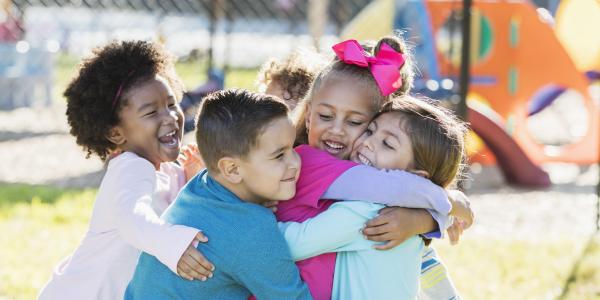
You are here
About the book, table of contents.
- I ntroduction
- Chapter 1: Examining Teacher Bias | Louise Derman-Sparks and Julie Olsen Edwards, with Catherine M. Goins
- Chapter 2: Developing Empathy to Build Warm, Inclusive Classrooms | Charis L. Wahman and Elizabeth A. Steed, with Susan Friedman
- Chapter 3: Valuing Diversity: Developing a Deeper Understanding of All Young Children’s Behavior | Barbara Kaiser and Judy Sklar Rasminsky
- Chapter 4: Connecting Culture and Play: Practical Strategies for Educators | Kamini Kamdar
- Chapter 5: The Balancing Act of Guided Play | Brenna Hassinger-Das, Kathy Hirsh-Pasek, and Roberta Michnick Golinkoff
- Chapter 6: Welcoming Refugee Children into Early Childhood Classrooms | Sadia Warsi
- Chapter 7: Creating a Culturally Responsive STEAM Curriculum | Anthony Broughton and Michiko B. McClary
- Chapter 8: Including All Children in Making and Tinkering! | Karen N. Nemeth and Pamela Brillante
- Chapter 9: Growing Little Storytellers | Ronald F. Ferguson and Tatsha Robertson
- Chapter 10: Books that Support Diversity, Conversations, and Play | Shannon B. Wanless and Patricia A. Crawford, with Susan Friedman
- Chapter 11: Six Things You Can Do to Prevent Preschool Expulsion | Alissa Mwenelupembe
- Chapter 12: Black Boys Matter: Cultivating Their Identity, Agency, and Voice | Brian L. Wright
- Chapter 13: Black Boys Matter: Strategies for a Culturally Responsive Classroom | Brian L. Wright
- Chapter 14: Supporting Emergent Bilingual Children: A Checklist for Early Childhood Educators | Shelley Pasnik and Naomi Hupert
- Chapter 15: Many Languages, One Classroom: Supporting Children in Superdiverse Settings | Carola Oliva-Olson, Linda M. Espinosa, Whit Hayslip, and Elizabeth S. Magruder
- Chapter 16: More Strategies for Supporting Children in Superdiverse Settings | Carola Oliva-Olson, Linda M. Espinosa, Whit Hayslip, and Elizabeth S. Magruder
- Chapter 17: Knock, Knock . . . Who's There? The Benefits of Home Visits in the Early Years | Jennifer K. Lampe
- Chapter 18: Conversations with Children! Asking Questions to Support Their Understanding of Family Diversity | Janis Strasser
- Chapter 19: When I Have a Mommy and a Mama: Including Children with All Types of Family Structures in the Classroom | Julia Luckenbill
- Fun, Easy Ways to Play with Math at Home: A Resource for Families | Jessica Mercer Young and Kristen E. Reed
- Chapter 21: “What If I Say the Wrong Thing?” Talking About Identity with Young Children | Nadia Jaboneta, with Deb Curtis
- Chapter 22: Pink Power and Bathroom Signs: Exploring Gender and Fairness | Jamie Solomon
- Chapter 23: “What About People Like Me?” Teaching Preschoolers About Segregation and “Peace Heroes” | Nadia Jaboneta
- Chapter 24: From Teacher to Equity Activist | Megan Pamela Ruth Madison
- R eferences
- A bout the Editors
Book Details
Related resources, position statement.
Advancing Equity in Early Childhood Education - All children have the right to equitable learning opportunities that help them achieve their full potential as engaged learners and valued members of society. Read the NAEYC's position statement on advancing equity.
Advancing Equity: Maximizing Learning in Diverse Classrooms - Watch this recorded webinar in which Tyrone Howard and Maurice Sykes discuss practical, classroom-based strategies for teacher and child agency in the service of social and racial justice.
Looking for more resources on EQUITY? Visit our topic page to browse our collection of articles on the topic.
Enrich your curriculum: purchase the module.
Promoting equity in your classroom is within your reach, and this on-demand mini-course will give you some of the tools you need. It focuses on what equity work can look like for teachers working with children ages 3 through 5 on a day-to-day basis in the classroom. You will find strategies and tips for how you can support the learning and development of each and every child in your classroom through intentional play opportunities and guided instructional supports. This module explores the six parts of the book to supplement your teaching and start or continue your journey towards a more equitable preschool classroom.
Recommendations For Authors & Photographers Catalog Webinars NAEYC Books List
Permissions Desk Copies FAQ
Books NAEYC Books List Catalog Quantity & Special Pricing
Susan Friedman is senior director of publications and content development at NAEYC. In this role, she leads the content development work of NAEYC’s books and periodicals teams. Ms. Friedman is coeditor of Each and Every Child: Teaching Preschool with an Equity Lens. She has extensive prior experience creating content on play, developmentally appropriate uses of media, and other topics for educators and families. She has presented at numerous educational conferences, including NAEYC’s Professional Learning Institute and Annual Conference, the South by Southwest Education (SXSW EDU) Conference & Festival, and the School Superintendents Association’s Early Learning Cohort. She began her career as a preschool teacher at City and Country School in New York City.
Alissa Mwenelupembe is the managing director, early learning at NAEYC and works out of the DC headquarters.
A child’s starting point matters—such an insightful and compelling message begins the journey of unpacking implicit biases in the field of early childhood. If you have been looking for a guide that operationalizes equity and shifts it into the reality of practice, this is the book for you. This is a game changer for the field of early learning.
— Marquita F. Davis, Deputy Director of Early Learning, Bill & Melinda Gates Foundation
As a society, we can and must do better to ensure all children have access to high-quality education. This resource provides concrete strategies, prompts readers with reflection questions, and sheds light on how personal biases and structural inequities impact our youngest learners. Eac h and Every Child will be tremendously helpful for early childhood educators, advocates, and policymakers working to achieve equity in our early childhood systems.
— Kassi Longoria, Diversity, Equity, and Inclusion Consultant, MAYA Consulting
Today’s early childhood classrooms demand attention to equity, and this book allows everyone from teachers to administrators the ability to understand why equity matters and how to embed it within the daily activities, interactions, and fabric of a program.
— Edward Manuszak, Superintendent, Dundee Community Schools
This is an essential, researched, and practical guide for empowering young children while advancing equity in the classroom. The diverse group of authors use strengths-based approaches that support identity development, engage families, and cultivate a stance for fairness and activism. Full of useful tools and strategies!
— Debbie LeeKeenan, Coauthor of From Survive to Thrive and Leading Anti-Bias Early Childhood Programs
Each and Every Child is practical, thought provoking, and a call to action. A must-read for early childhood educators committed to social justice and equity in early childhood education.
— Lorena Mancilla, Director, WIDA Early Years at the Wisconsin Center for Education Research
This book brings the NAEYC advancing equity position statement to life. Filled with stories, practical tips, and self-reflections, it is an excellent resource for all who work in the early childhood field.
— Titus DosRemedios, Director of Research and Policy, Strategies for Children
As early childhood educators, we have an obligation to embrace diversity and advance equity efforts in our profession. This book identifies the structural inequities that can interfere with a child’s learning and offers an engaging, strengths-based approach to addressing them.
— William Mosier, Director of Research, Lynda A. Cohen Center for the Study of Child Development, and Professor of Child Development, Istanbul University
This edited book by Friedman and Mwenelupembe is filled with vivid real-life scenarios, and thus it is extremely applicable and beneficial to various stakeholders who are wondering how equity-based pedagogy can be enacted with preschool age children. In response to a possible rebuttal that preschoolers are too young to be exposed to issues of equity, race, etc., Friedman and Mwenelupembe make a strong case based on recent research findings that the negative impact of implicit bias begins in early years and that young children are extremely capable of making sense of these sensitive issues.
—Excerpt from Teachers College Record review by Sophia Han
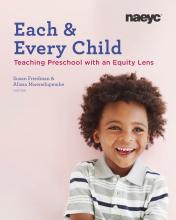
- Education & Teaching
- Schools & Teaching
Fulfillment by Amazon (FBA) is a service we offer sellers that lets them store their products in Amazon's fulfillment centers, and we directly pack, ship, and provide customer service for these products. Something we hope you'll especially enjoy: FBA items qualify for FREE Shipping and Amazon Prime.
If you're a seller, Fulfillment by Amazon can help you grow your business. Learn more about the program.
| This item cannot be shipped to your selected delivery location. Please choose a different delivery location. |
Sorry, there was a problem.

Download the free Kindle app and start reading Kindle books instantly on your smartphone, tablet, or computer - no Kindle device required .
Read instantly on your browser with Kindle for Web.
Using your mobile phone camera - scan the code below and download the Kindle app.

Image Unavailable

- To view this video download Flash Player
Introduction to Early Childhood Education 8th Edition
- ISBN-10 1544338759
- ISBN-13 978-1544338750
- Edition 8th
- Publication date February 21, 2019
- Language English
- Dimensions 8.5 x 1.12 x 11 inches
- Print length 496 pages
- See all details
Editorial Reviews
About the author.
Dr. Eva Essa is a retired professor of Human Development and Family Studies. She taught child development and early childhood education classes for 41 years at the University of Nevada, Reno. For 16 of those years she also served as the director of the Child and Family Research Center, which shifted from being a small laboratory school to a full-time program for infants, toddlers, and preschool-aged children of students, faculty, and staff during Dr. Essa’s years as director. Dr. Essa published several other books and numerous articles relevant to early childhood education. She has also been involved in a range of professional activities on campus, within the community, throughout the state, and nationally.
Dr. Melissa Burnham is the Associate Dean for the College of Education and Professor of Human Development and Family Studies and Early Childhood Education. She has been a faculty member at the University of Nevada, Reno since the fall of 2001. Dr. Burnham′s research interests focus on the examination of infant and child development in context. She has studied the impact of quality early care and education on child development and P-3 educational reform efforts, and has been involved in P-3 work at the local and state levels in Nevada since 2011. Dr. Burnham has worked on an initiative resulting in existing primary grade teachers obtaining licensure in Early Childhood Education, and in the creation of a new Educational Leadership principal preparation program in collaboration with a local school district. Thus, her work spans research, policy, and practice.
Product details
- Publisher : SAGE Publications, Inc; 8th edition (February 21, 2019)
- Language : English
- Paperback : 496 pages
- ISBN-10 : 1544338759
- ISBN-13 : 978-1544338750
- Item Weight : 2.4 pounds
- Dimensions : 8.5 x 1.12 x 11 inches
- #816 in Early Childhood Education
- #1,339 in Core
- #1,760 in Education (Books)
Customer reviews
Our goal is to make sure every review is trustworthy and useful. That's why we use both technology and human investigators to block fake reviews before customers ever see them. Learn more
We block Amazon accounts that violate our community guidelines. We also block sellers who buy reviews and take legal actions against parties who provide these reviews. Learn how to report
- Sort reviews by Top reviews Most recent Top reviews
Top reviews from the United States
There was a problem filtering reviews right now. please try again later..
- About Amazon
- Investor Relations
- Amazon Devices
- Amazon Science
- Sell products on Amazon
- Sell on Amazon Business
- Sell apps on Amazon
- Become an Affiliate
- Advertise Your Products
- Self-Publish with Us
- Host an Amazon Hub
- › See More Make Money with Us
- Amazon Business Card
- Shop with Points
- Reload Your Balance
- Amazon Currency Converter
- Amazon and COVID-19
- Your Account
- Your Orders
- Shipping Rates & Policies
- Returns & Replacements
- Manage Your Content and Devices
- Amazon Assistant
- Conditions of Use
- Privacy Notice
- Consumer Health Data Privacy Disclosure
- Your Ads Privacy Choices
- Technical Support
- Find My Rep
You are here
Introduction to Early Childhood Education
- Eva L. Essa - University of Nevada, Reno
- Melissa M. Burnham - University of Nevada, Reno
- Description
- SAGE Premium Video Included in the interactive eBook! SAGE Premium Video tools and resources boost comprehension and bolster analysis. Learn more .
- Interactive eBook Your students save when you bundle the print version with the Interactive eBook (Bundle ISBN: 978-1-5443-6883-2), which includes access to SAGE Premium Video and other multimedia tools. Learn more .
- SAGE coursepacks SAGE coursepacks makes it easy to import our quality instructor and student resource content into your school’s learning management system (LMS). Intuitive and simple to use, SAGE coursepacks allows you to customize course content to meet your students’ needs. Learn more .
- SAGE edge This companion website offers both instructors and students a robust online environment with an impressive array of teaching and learning resources. Learn more .
| ISBN: 9781544338736 | Electronic Version | Suggested Retail Price: $101.00 | Bookstore Price: $80.80 |
| ISBN: 9781544338750 | Paperback | Suggested Retail Price: $151.00 | Bookstore Price: $120.80 |
| ISBN: 9781544338743 | Loose-leaf | Suggested Retail Price: $121.00 | Bookstore Price: $96.80 |
See what’s new to this edition by selecting the Features tab on this page. Should you need additional information or have questions regarding the HEOA information provided for this title, including what is new to this edition, please email [email protected] . Please include your name, contact information, and the name of the title for which you would like more information. For information on the HEOA, please go to http://ed.gov/policy/highered/leg/hea08/index.html .
For assistance with your order: Please email us at [email protected] or connect with your SAGE representative.
SAGE 2455 Teller Road Thousand Oaks, CA 91320 www.sagepub.com
Supplements
edge.sagepub.com/essa8e
SAGE edge for students enhances learning, it’s easy to use, and offers:
- an open-access site that makes it easy for students to maximize their study time, anywhere, anytime;
- eF lashcards that strengthen understanding of key terms and concepts;
- eQ uizzes that allow students to practice and assess how much they’ve learned and where they need to focus their attention;
- exclusive access to influential SAGE journal articles that tie important research and scholarship to chapter concepts to strengthen learning; and
- video and multimedia links that facilitate student use of Internet resources, further exploration of topics, and responses to critical thinking questions.
“Great book for helping students identify developmentally appropriate standards and practices.”
“A foundational text for early childhood education topics that is cognizant of and responsive to the current practices and concerns that recent brain-based research encourages EC practitioners to be aware of and proficient in for the success of the whole child. The text's features makes it more approachable than most texts, while simultaneously providing a myriad of prompts for further discussion and/or reflection.”
“Essa and Burnham’s text is clear and concise, and presents information in an easy-to-understand format for my students. The textbook includes NAEYC standards and stresses Developmentally Appropriate Practices and play.”
“This book provides the historical contexts, rationale, and a great overview of the early childhood profession.”
- New co-author Melissa Burnham contributes in-depth knowledge of child development, extensive understanding of brain architecture, application of the latest brain research to practice, and a deep comprehension of progressive models of education.
- This edition reflects the latest research, statistics, policy, and changes in the field of early childhood education , providing the latest information as students enter the field.
- All chapters now begin with specific learning objectives based on Bloom’s Taxonomy , helping to better organize the chapters and tie the objectives to the main sub-sections as well as to the NAEYC Standards for Professional Preparation Programs.
- All chapters list the specific NAEYC standard(s) met in the section and include in-depth links leading to NAEYC Standards for further study.
- The renamed feature, Brain Science, focuses on recent brain development research, tying an aspect of child development to the study of the brain and discussing how and why this research is relevant to early childhood education practitioners.
- Video cases , included in the Interactive eBook, offer students the opportunity to observe real-life educators and classroo ms to provide teachers-in-training a sense of what to expect in their future classrooms.
- Thorough coverage of STEM (Science, Technology, Engineering, and Math) and STEAM (Science, Technology, Engineering, Arts, and Math) discusses the role of digital tools as an avenue for engaging creative activities, while also acknowledging ways in which electronic media can possibly impede creativity.
- An expanded discussion surrounding ever-changing technology is included throughout.
KEY FEATURES:
- Learning Objectives at the beginning of each chapter prepare readers for encountering the material covered in each chapter and provide clear direction for navigating the content.
- Learning Objectives are paired with NAEYC Standards —a summary of the standards discussed in each chapter are provided, preparing readers for which standards will be covered and where they are discussed in more depth.
- Each chapter opens with a quotation from the book, Developmentally Appropriate Practice (DAP) to underscore the importance of this topic in the field of early childhood education.
- The Take a Closer Look feature offers in-depth information about a topic of importance to the field of early childhood education.
- Stories from the Field are found in each chapter and feature a story from an early childhood practitioner, providing firsthand narratives and insight into what makes working with young children meaningful to professionals.
- Working with Families sections focus on one of the important tasks of early childhood teachers—communicating, coordinating, and working with families—demonstrating how parents and other family members are integral to early childhood programs.
- Key Questions are posed at the end of each chapter to help readers reflect on the information and further explore its relevance, with some questions suggesting activities to reinforce understanding of the topic.
- End-of-chapter study tools include chapter summaries and additional resources, including books, articles, and websites that contain information relevant to early childhood education in relation to the topic of the chapter.

Sample Materials & Chapters
Chapter 1: The Scope of and Need for Early Childhood Education
Chapter 9: Scheduling and Curriculum Planning
For instructors
Select a purchasing option.
Shipped Options:
BUNDLE: Essa: Introduction to Early Childhood Education, 8e (Loose-leaf) +Interactive eBook
BUNDLE: Essa: Introduction to Early Childhood Education, 8e (Paperback) +Interactive eBook
Related Products

You are using an outdated browser. Please upgrade your browser to improve your experience and security.
Early Childhood Education
Explore more.

Out of Stock

from $11.39
Bestsellers

from $25.39
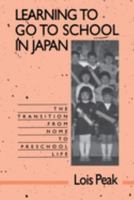
from $58.49
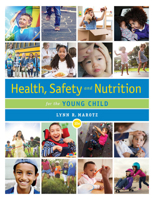
Non-Fiction
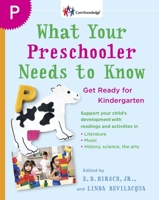
from $24.21

from $16.69
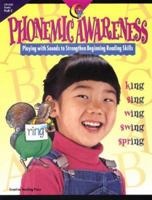
from $10.59

from $11.79

from $10.09

Education & Reference
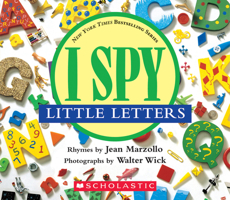
from $12.49

Elementary Education
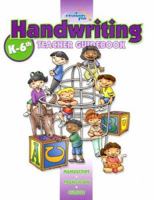
Instruction Methods

from $17.49
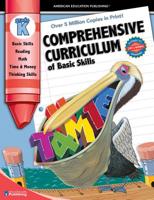
Schools & Teaching
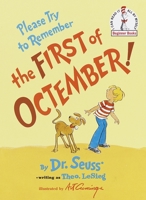
from $12.89
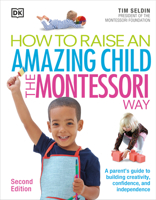
Commonalities among these books on Early Childhood Education include a focus on child development, the importance of play-based learning, and the use of hands-on activities to promote learning. Many of the books also discuss specific approaches to teaching, such as Montessori or Reggio Emilia, and provide practical advice for educators and parents. Additionally, there are numerous guides for teaching specific subjects like reading, math, and art. Overall, these books aim to support the growth and development of young children through engaging and effective educational practices.
Popular Categories
- Teen and Young Adult
- Literature & Fiction
- Mystery & Thriller
- Sci-fi & Fantasy
- Large Print Books
- Rare & Collectible Books
- ShareBookLove
- Educator Benefits
- Librarian Benefits
- e-Gift Cards
- View Mobile Site
- Shopping Cart
- Order History
Partnerships
- Library Program
- Help & Support
- Shipping Costs
- Return Policy
- Website Suggestions
- Our Purpose
- Social Responsibility
- Testimonials
Current time by city
For example, New York
Current time by country
For example, Japan
Time difference
For example, London
For example, Dubai
Coordinates
For example, Hong Kong
For example, Delhi
For example, Sydney
Geographic coordinates of Elektrostal, Moscow Oblast, Russia
City coordinates
Coordinates of Elektrostal in decimal degrees
Coordinates of elektrostal in degrees and decimal minutes, utm coordinates of elektrostal, geographic coordinate systems.
WGS 84 coordinate reference system is the latest revision of the World Geodetic System, which is used in mapping and navigation, including GPS satellite navigation system (the Global Positioning System).
Geographic coordinates (latitude and longitude) define a position on the Earth’s surface. Coordinates are angular units. The canonical form of latitude and longitude representation uses degrees (°), minutes (′), and seconds (″). GPS systems widely use coordinates in degrees and decimal minutes, or in decimal degrees.
Latitude varies from −90° to 90°. The latitude of the Equator is 0°; the latitude of the South Pole is −90°; the latitude of the North Pole is 90°. Positive latitude values correspond to the geographic locations north of the Equator (abbrev. N). Negative latitude values correspond to the geographic locations south of the Equator (abbrev. S).
Longitude is counted from the prime meridian ( IERS Reference Meridian for WGS 84) and varies from −180° to 180°. Positive longitude values correspond to the geographic locations east of the prime meridian (abbrev. E). Negative longitude values correspond to the geographic locations west of the prime meridian (abbrev. W).
UTM or Universal Transverse Mercator coordinate system divides the Earth’s surface into 60 longitudinal zones. The coordinates of a location within each zone are defined as a planar coordinate pair related to the intersection of the equator and the zone’s central meridian, and measured in meters.
Elevation above sea level is a measure of a geographic location’s height. We are using the global digital elevation model GTOPO30 .
Elektrostal , Moscow Oblast, Russia

- Bahasa Indonesia
- Eastern Europe
- Moscow Oblast
Elektrostal
Elektrostal Localisation : Country Russia , Oblast Moscow Oblast . Available Information : Geographical coordinates , Population, Altitude, Area, Weather and Hotel . Nearby cities and villages : Noginsk , Pavlovsky Posad and Staraya Kupavna .
Information
Find all the information of Elektrostal or click on the section of your choice in the left menu.
- Update data
| Country | |
|---|---|
| Oblast |
Elektrostal Demography
Information on the people and the population of Elektrostal.
| Elektrostal Population | 157,409 inhabitants |
|---|---|
| Elektrostal Population Density | 3,179.3 /km² (8,234.4 /sq mi) |
Elektrostal Geography
Geographic Information regarding City of Elektrostal .
| Elektrostal Geographical coordinates | Latitude: , Longitude: 55° 48′ 0″ North, 38° 27′ 0″ East |
|---|---|
| Elektrostal Area | 4,951 hectares 49.51 km² (19.12 sq mi) |
| Elektrostal Altitude | 164 m (538 ft) |
| Elektrostal Climate | Humid continental climate (Köppen climate classification: Dfb) |
Elektrostal Distance
Distance (in kilometers) between Elektrostal and the biggest cities of Russia.
Elektrostal Map
Locate simply the city of Elektrostal through the card, map and satellite image of the city.
Elektrostal Nearby cities and villages
Elektrostal Weather
Weather forecast for the next coming days and current time of Elektrostal.
Elektrostal Sunrise and sunset
Find below the times of sunrise and sunset calculated 7 days to Elektrostal.
| Day | Sunrise and sunset | Twilight | Nautical twilight | Astronomical twilight |
|---|---|---|---|---|
| 8 June | 02:43 - 11:25 - 20:07 | 01:43 - 21:07 | 01:00 - 01:00 | 01:00 - 01:00 |
| 9 June | 02:42 - 11:25 - 20:08 | 01:42 - 21:08 | 01:00 - 01:00 | 01:00 - 01:00 |
| 10 June | 02:42 - 11:25 - 20:09 | 01:41 - 21:09 | 01:00 - 01:00 | 01:00 - 01:00 |
| 11 June | 02:41 - 11:25 - 20:10 | 01:41 - 21:10 | 01:00 - 01:00 | 01:00 - 01:00 |
| 12 June | 02:41 - 11:26 - 20:11 | 01:40 - 21:11 | 01:00 - 01:00 | 01:00 - 01:00 |
| 13 June | 02:40 - 11:26 - 20:11 | 01:40 - 21:12 | 01:00 - 01:00 | 01:00 - 01:00 |
| 14 June | 02:40 - 11:26 - 20:12 | 01:39 - 21:13 | 01:00 - 01:00 | 01:00 - 01:00 |
Elektrostal Hotel
Our team has selected for you a list of hotel in Elektrostal classified by value for money. Book your hotel room at the best price.
| Located next to Noginskoye Highway in Electrostal, Apelsin Hotel offers comfortable rooms with free Wi-Fi. Free parking is available. The elegant rooms are air conditioned and feature a flat-screen satellite TV and fridge... | from | |
| Located in the green area Yamskiye Woods, 5 km from Elektrostal city centre, this hotel features a sauna and a restaurant. It offers rooms with a kitchen... | from | |
| Ekotel Bogorodsk Hotel is located in a picturesque park near Chernogolovsky Pond. It features an indoor swimming pool and a wellness centre. Free Wi-Fi and private parking are provided... | from | |
| Surrounded by 420,000 m² of parkland and overlooking Kovershi Lake, this hotel outside Moscow offers spa and fitness facilities, and a private beach area with volleyball court and loungers... | from | |
| Surrounded by green parklands, this hotel in the Moscow region features 2 restaurants, a bowling alley with bar, and several spa and fitness facilities. Moscow Ring Road is 17 km away... | from | |
Elektrostal Nearby
Below is a list of activities and point of interest in Elektrostal and its surroundings.
Further information about the population structure:
| Gender (C 2021) | |
|---|---|
| Males | 66,545 |
| Females | 79,858 |
Located in:
- Èlektrostal' urban district
- Moskva Oblast

40 Facts About Elektrostal
Written by Lanette Mayes
Modified & Updated: 01 Jun 2024
Reviewed by Jessica Corbett

Elektrostal is a vibrant city located in the Moscow Oblast region of Russia. With a rich history, stunning architecture, and a thriving community, Elektrostal is a city that has much to offer. Whether you are a history buff, nature enthusiast, or simply curious about different cultures, Elektrostal is sure to captivate you.
This article will provide you with 40 fascinating facts about Elektrostal, giving you a better understanding of why this city is worth exploring. From its origins as an industrial hub to its modern-day charm, we will delve into the various aspects that make Elektrostal a unique and must-visit destination.
So, join us as we uncover the hidden treasures of Elektrostal and discover what makes this city a true gem in the heart of Russia.
Key Takeaways:
- Elektrostal, known as the “Motor City of Russia,” is a vibrant and growing city with a rich industrial history, offering diverse cultural experiences and a strong commitment to environmental sustainability.
- With its convenient location near Moscow, Elektrostal provides a picturesque landscape, vibrant nightlife, and a range of recreational activities, making it an ideal destination for residents and visitors alike.
Known as the “Motor City of Russia.”
Elektrostal, a city located in the Moscow Oblast region of Russia, earned the nickname “Motor City” due to its significant involvement in the automotive industry.
Home to the Elektrostal Metallurgical Plant.
Elektrostal is renowned for its metallurgical plant, which has been producing high-quality steel and alloys since its establishment in 1916.
Boasts a rich industrial heritage.
Elektrostal has a long history of industrial development, contributing to the growth and progress of the region.
Founded in 1916.
The city of Elektrostal was founded in 1916 as a result of the construction of the Elektrostal Metallurgical Plant.
Located approximately 50 kilometers east of Moscow.
Elektrostal is situated in close proximity to the Russian capital, making it easily accessible for both residents and visitors.
Known for its vibrant cultural scene.
Elektrostal is home to several cultural institutions, including museums, theaters, and art galleries that showcase the city’s rich artistic heritage.
A popular destination for nature lovers.
Surrounded by picturesque landscapes and forests, Elektrostal offers ample opportunities for outdoor activities such as hiking, camping, and birdwatching.
Hosts the annual Elektrostal City Day celebrations.
Every year, Elektrostal organizes festive events and activities to celebrate its founding, bringing together residents and visitors in a spirit of unity and joy.
Has a population of approximately 160,000 people.
Elektrostal is home to a diverse and vibrant community of around 160,000 residents, contributing to its dynamic atmosphere.
Boasts excellent education facilities.
The city is known for its well-established educational institutions, providing quality education to students of all ages.
A center for scientific research and innovation.
Elektrostal serves as an important hub for scientific research, particularly in the fields of metallurgy , materials science, and engineering.
Surrounded by picturesque lakes.
The city is blessed with numerous beautiful lakes , offering scenic views and recreational opportunities for locals and visitors alike.
Well-connected transportation system.
Elektrostal benefits from an efficient transportation network, including highways, railways, and public transportation options, ensuring convenient travel within and beyond the city.
Famous for its traditional Russian cuisine.
Food enthusiasts can indulge in authentic Russian dishes at numerous restaurants and cafes scattered throughout Elektrostal.
Home to notable architectural landmarks.
Elektrostal boasts impressive architecture, including the Church of the Transfiguration of the Lord and the Elektrostal Palace of Culture.
Offers a wide range of recreational facilities.
Residents and visitors can enjoy various recreational activities, such as sports complexes, swimming pools, and fitness centers, enhancing the overall quality of life.
Provides a high standard of healthcare.
Elektrostal is equipped with modern medical facilities, ensuring residents have access to quality healthcare services.
Home to the Elektrostal History Museum.
The Elektrostal History Museum showcases the city’s fascinating past through exhibitions and displays.
A hub for sports enthusiasts.
Elektrostal is passionate about sports, with numerous stadiums, arenas, and sports clubs offering opportunities for athletes and spectators.
Celebrates diverse cultural festivals.
Throughout the year, Elektrostal hosts a variety of cultural festivals, celebrating different ethnicities, traditions, and art forms.
Electric power played a significant role in its early development.
Elektrostal owes its name and initial growth to the establishment of electric power stations and the utilization of electricity in the industrial sector.
Boasts a thriving economy.
The city’s strong industrial base, coupled with its strategic location near Moscow, has contributed to Elektrostal’s prosperous economic status.
Houses the Elektrostal Drama Theater.
The Elektrostal Drama Theater is a cultural centerpiece, attracting theater enthusiasts from far and wide.
Popular destination for winter sports.
Elektrostal’s proximity to ski resorts and winter sport facilities makes it a favorite destination for skiing, snowboarding, and other winter activities.
Promotes environmental sustainability.
Elektrostal prioritizes environmental protection and sustainability, implementing initiatives to reduce pollution and preserve natural resources.
Home to renowned educational institutions.
Elektrostal is known for its prestigious schools and universities, offering a wide range of academic programs to students.
Committed to cultural preservation.
The city values its cultural heritage and takes active steps to preserve and promote traditional customs, crafts, and arts.
Hosts an annual International Film Festival.
The Elektrostal International Film Festival attracts filmmakers and cinema enthusiasts from around the world, showcasing a diverse range of films.
Encourages entrepreneurship and innovation.
Elektrostal supports aspiring entrepreneurs and fosters a culture of innovation, providing opportunities for startups and business development .
Offers a range of housing options.
Elektrostal provides diverse housing options, including apartments, houses, and residential complexes, catering to different lifestyles and budgets.
Home to notable sports teams.
Elektrostal is proud of its sports legacy , with several successful sports teams competing at regional and national levels.
Boasts a vibrant nightlife scene.
Residents and visitors can enjoy a lively nightlife in Elektrostal, with numerous bars, clubs, and entertainment venues.
Promotes cultural exchange and international relations.
Elektrostal actively engages in international partnerships, cultural exchanges, and diplomatic collaborations to foster global connections.
Surrounded by beautiful nature reserves.
Nearby nature reserves, such as the Barybino Forest and Luchinskoye Lake, offer opportunities for nature enthusiasts to explore and appreciate the region’s biodiversity.
Commemorates historical events.
The city pays tribute to significant historical events through memorials, monuments, and exhibitions, ensuring the preservation of collective memory.
Promotes sports and youth development.
Elektrostal invests in sports infrastructure and programs to encourage youth participation, health, and physical fitness.
Hosts annual cultural and artistic festivals.
Throughout the year, Elektrostal celebrates its cultural diversity through festivals dedicated to music, dance, art, and theater.
Provides a picturesque landscape for photography enthusiasts.
The city’s scenic beauty, architectural landmarks, and natural surroundings make it a paradise for photographers.
Connects to Moscow via a direct train line.
The convenient train connection between Elektrostal and Moscow makes commuting between the two cities effortless.
A city with a bright future.
Elektrostal continues to grow and develop, aiming to become a model city in terms of infrastructure, sustainability, and quality of life for its residents.
In conclusion, Elektrostal is a fascinating city with a rich history and a vibrant present. From its origins as a center of steel production to its modern-day status as a hub for education and industry, Elektrostal has plenty to offer both residents and visitors. With its beautiful parks, cultural attractions, and proximity to Moscow, there is no shortage of things to see and do in this dynamic city. Whether you’re interested in exploring its historical landmarks, enjoying outdoor activities, or immersing yourself in the local culture, Elektrostal has something for everyone. So, next time you find yourself in the Moscow region, don’t miss the opportunity to discover the hidden gems of Elektrostal.
Q: What is the population of Elektrostal?
A: As of the latest data, the population of Elektrostal is approximately XXXX.
Q: How far is Elektrostal from Moscow?
A: Elektrostal is located approximately XX kilometers away from Moscow.
Q: Are there any famous landmarks in Elektrostal?
A: Yes, Elektrostal is home to several notable landmarks, including XXXX and XXXX.
Q: What industries are prominent in Elektrostal?
A: Elektrostal is known for its steel production industry and is also a center for engineering and manufacturing.
Q: Are there any universities or educational institutions in Elektrostal?
A: Yes, Elektrostal is home to XXXX University and several other educational institutions.
Q: What are some popular outdoor activities in Elektrostal?
A: Elektrostal offers several outdoor activities, such as hiking, cycling, and picnicking in its beautiful parks.
Q: Is Elektrostal well-connected in terms of transportation?
A: Yes, Elektrostal has good transportation links, including trains and buses, making it easily accessible from nearby cities.
Q: Are there any annual events or festivals in Elektrostal?
A: Yes, Elektrostal hosts various events and festivals throughout the year, including XXXX and XXXX.
Elektrostal's fascinating history, vibrant culture, and promising future make it a city worth exploring. For more captivating facts about cities around the world, discover the unique characteristics that define each city . Uncover the hidden gems of Moscow Oblast through our in-depth look at Kolomna. Lastly, dive into the rich industrial heritage of Teesside, a thriving industrial center with its own story to tell.
Was this page helpful?
Our commitment to delivering trustworthy and engaging content is at the heart of what we do. Each fact on our site is contributed by real users like you, bringing a wealth of diverse insights and information. To ensure the highest standards of accuracy and reliability, our dedicated editors meticulously review each submission. This process guarantees that the facts we share are not only fascinating but also credible. Trust in our commitment to quality and authenticity as you explore and learn with us.
Share this Fact:

COMMENTS
A list of books for parents, educators, and professionals who work with young learners from birth to grade 5. The books cover topics such as brain development, communication, inclusion, diversity, and curriculum.
The 20 best early childhood education books recommended by Sharon Lynn Kagan and Mary Myatt, such as School Zone and The Exceptional Child.
Book Recommendations. NAEYC publishes well-respected books that reflect the latest research on a range of topics in early childhood education. Take a look at our book recommendations! For information about ordering our resources, please go here . NAEYC is committed to providing the best possible resources to support effective teaching and ...
Introduction to Early Childhood Education provides current and future educators with a highly readable, comprehensive overview of the field. The underlying philosophy of the book is that early childhood educators' most important task is to provide a program that is sensitive to and supports the development of young children. Author Eva L. Essa and new co-author Melissa Burnham provide ...
The Young Child and Mathematics, Third Edition, focuses on finding, encouraging, and supporting math thinking throughout the day. Math learning opportunities are highlighted both inside and outside of spaces typically thought of as "math time.". Rather than a detailed account of what is involved in early childhood mathematics, this book ...
Discover a curated selection of early childhood education books on Goodreads, featuring expert strategies and insights for nurturing young minds.
Explore our list of Early Childhood Education Books at Barnes & Noble®. Get your order fast and stress free with free curbside pickup.
The lists of books for parents about early childhood development are numerous, but have you recently thought about the best book for your own kids to read? Books that will stimulate their intellectual development, engage their curiosity, and teach them subtle lessons while introducing them to the joy and pleasure of words. That is what this early childhood book list is all about.
This early childhood education text is clearly and beautifully written and presented with research based, comprehensive and practical information on the development and instruction of children addressing their early education environment with appropriate learning strategies.
Developed by pediatric physicians, healthcare providers, and early childhood educators, the fully revised sixth edition of Healthy Young Children focuses on how education and healthcare professionals can work with children and families to promote physical and mental health and provide safe and healthy environments.
Become an organizational or corporate partner to inspire early childhood education at the local and national level. News and Updates Stay current on all things related to your professional association, from book releases to policy updates.
She holds a doctorate in early childhood education, is a licensed teacher, and is a national speaker, child behavior expert, and author of multiple books and articles that address research-based, practical skills for behavior guidance, high-quality teaching, family child care, leadership, and parenting. ... This book encourages early childhood ...
Advancing Equity and Embracing Diversity in Early Childhood Education: Elevating Voices and Actions. Coaching with Powerful Interactions: A Guide for Partnering with Early Childhood Teachers, Second Edition. Ethics and the Early Childhood Educator: Using the NAEYC Code, Third Edition. From Survive to Thrive: A Director's Guide for Leading an ...
Expanded discussions of ways to support and protect the role of play in children's education, a completely revised chapter on STEM teaching and learning, and a greater focus on culturally responsive curriculum keep readers up to date on the dynamic field of early education. Effective Practices in Early Childhood Education, 4th Edition is also ...
This resource provides concrete strategies, prompts readers with reflection questions, and sheds light on how personal biases and structural inequities impact our youngest learners. Each and Every Child will be tremendously helpful for early childhood educators, advocates, and policymakers working to achieve equity in our early childhood systems.
The Early Years Matter: Education, Care, and the Well-Being of Children, Birth to 8 (Early Childhood Education Series) Part of: Early Childhood Education (71 books) 4.8 out of 5 stars
Introduction to Early Childhood Education provides current and future educators with a highly readable, comprehensive overview of the field. The underlying philosophy of the book is that early childhood educators' most important task is to provide a program that is sensitive to and supports the development of young children. Author Eva L ...
Introduction to Early Childhood Education provides current and future educators with a highly readable, comprehensive overview of the field. The underlying philosophy of the book is that early childhood educators' most important task is to provide a program that is sensitive to and supports the development of young children.
Commonalities among these books on Early Childhood Education include a focus on child development, the importance of play-based learning, and the use of hands-on activities to promote learning. Many of the books also discuss specific approaches to teaching, such as Montessori or Reggio Emilia, and provide practical advice for educators and ...
Geographic coordinate systems. WGS 84 coordinate reference system is the latest revision of the World Geodetic System, which is used in mapping and navigation, including GPS satellite navigation system (the Global Positioning System).
Elektrostal : Elektrostal Localisation : Country Russia, Oblast Moscow Oblast. Available Information : Geographical coordinates, Population, Area, Altitude, Weather and Hotel. Nearby cities and villages : Noginsk, Pavlovsky Posad and Staraya Kupavna. - City, Town and Village of the world
Èlektrostal' (Moscow Oblast, Russia) with population statistics, charts, map, location, weather and web information.
Boasts excellent education facilities. The city is known for its well-established educational institutions, providing quality education to students of all ages. A center for scientific research and innovation. ... Electric power played a significant role in its early development.